The Dordogne is considered one of the most beautiful rivers for paddling in Europe. The natural course of the river alone, with its ever-changing character of hills, meadows and steep cliffs, makes every paddler’s heart beat faster. In addition, castles, fortresses, medieval villages and caves characterise the Dordogne Valley and make a canoe trip a cultural experience. We have been on the Dordogne for 6 days and in this article we would like to take you with us back on the river and share our adventure with you.
Key facts about the paddling tour
Duration
6 – 7 days
Culture
castles, medieval villages
Public transport
car needed
Traffic noise
rarely and little traffic noise
Landscape
cliffs, meadows, hills
Table of Contents
The Dordogne as a paddle region
The Dordogne is a 305 miles (490 km) long river in the southwest of France. The region is considered an Eldorado for paddlers thanks to its diverse nature with picturesque valleys and rocks, its well-preserved and restored villages and castles. The shallow course of the river (max. white water class II) and the mild climate attract numerous paddle beginners and families to the region every year.
The 93 miles (150 km) long section between Argentat and Limeuil is particularly interesting for river paddling. The section is mostly natural and only limited by two weirs, which can be easily circumnavigated with a boat slide. The highlight of every Dordogne tour is without doubt the section between Vitrac and Beynac-et-Cazenac with its distinctive castle landscape. After Beynac-et-Cazenac the landscape becomes less exciting, but on this section up to Limeuil you can end the tour in peace even in high summer. Behind Limeuil the river becomes wide and sluggish and is characterized by many weirs, which makes the trip less interesting for most paddlers.
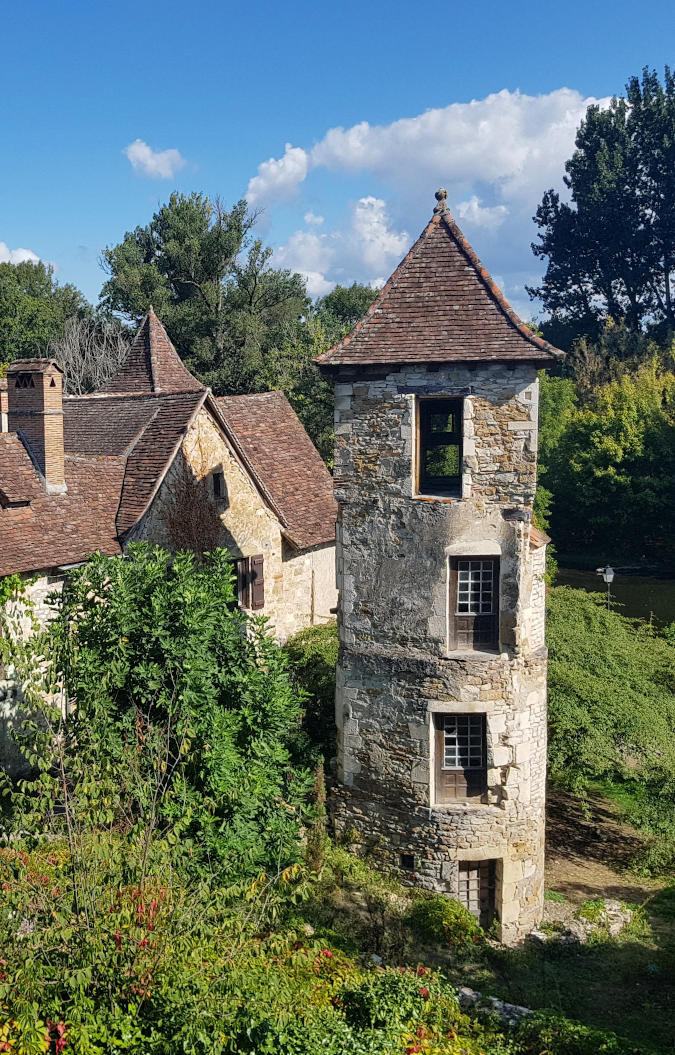
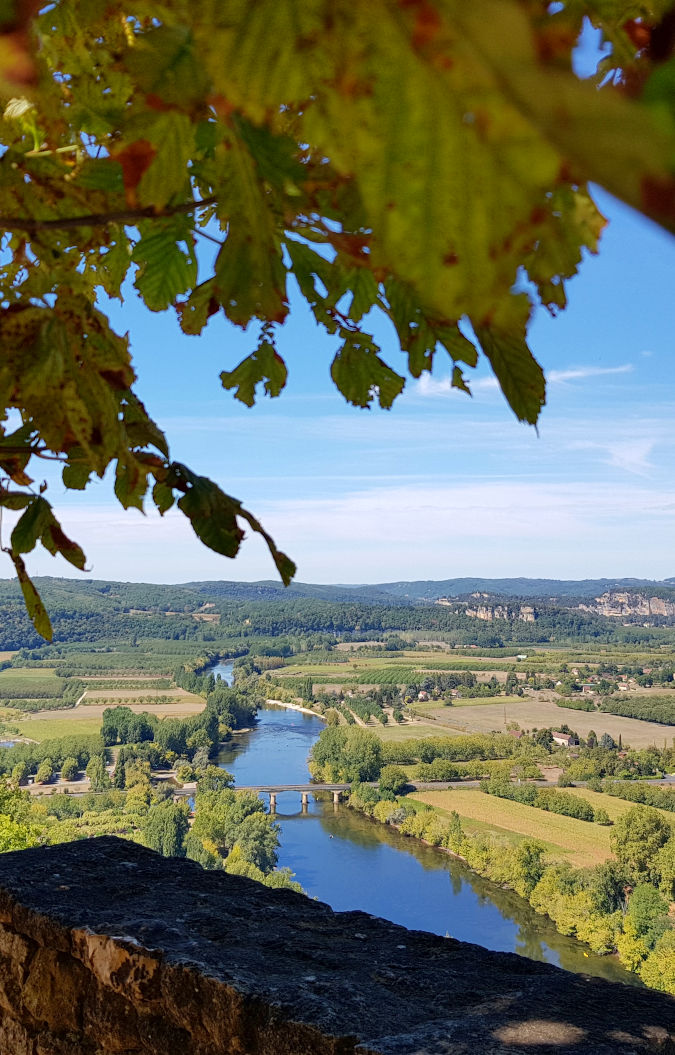
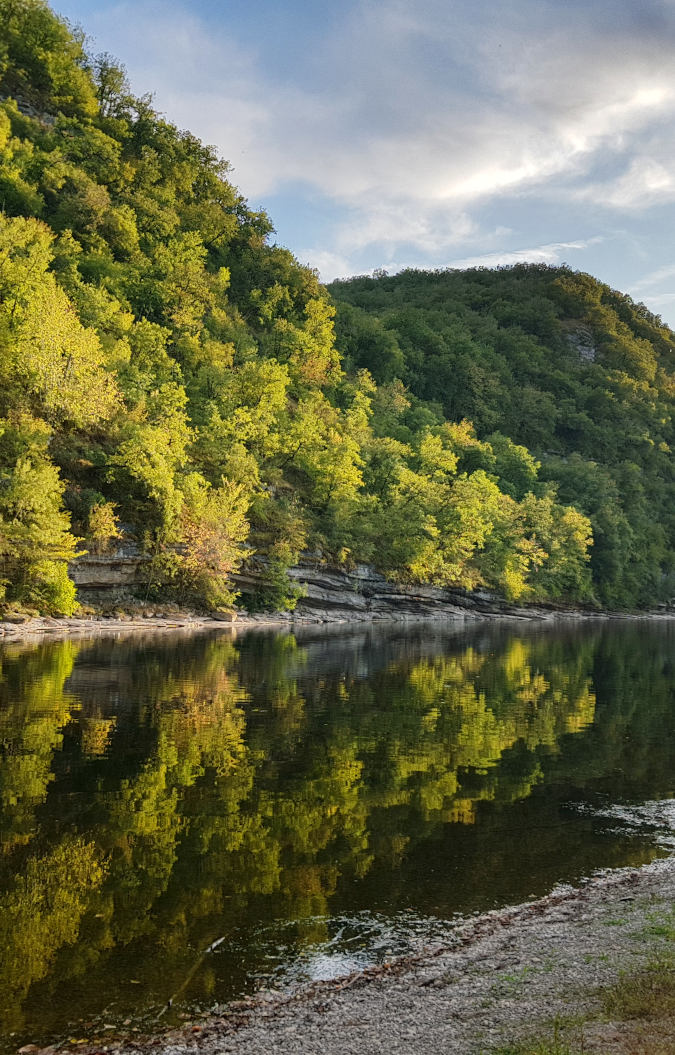
The Dordogne is ideal for paddling tours lasting several days. It is varied and does not get boring. The numerous villages on the banks of the Dordogne offer the opportunity to replenish your own provisions or to stop off in a restaurant. Due to the numerous campsites and the accommodations in the villages, you will find a suitable stay every evening. In the high season, however, you have to be prepared for the fact that many hotels and popular campsites are already fully booked.
Those who are not a big fan of longer paddle tours can also do a day trip. There are several possibilities, but the most popular section is the one between Vitrac and Beynac-et-Cazennac. However, this section is strongly frequented by many day tourists. Canoe rentals pick you up at the end of the paddle tour with a minibus and take you back where you started your tour.
Getting to the Dordogne in France
Toulouse and Bordeaux, where numerous flight connections exist, are the closest big cities. From these two cities you are within 3.5 hours by car in the Dordogne region. We recommend that you take a rental car, which can be rented at the airport or in the city centre. The journey with the public transport is possible, but unfortunately from the two cities mentioned above quite time-consuming and complicated. This is mainly due to the fact that the region is economically underdeveloped and dominated by agriculture. Train connections to the larger cities do exist, but there are only a few and no direct connections.
If you don’t want to travel by car, you could also start the canoe tour in Souillac. Souillac is the biggest city in the region and has a direct train connection to Paris. For the departure you should organize a transport to Souillac. If you hire a boat from a canoe rental company, they will usually return you to your starting point. If you are travelling with your own inflatable canoe, you can still contact a canoe rental company in order to ask them for a return transport. If they have space in their minibuses on their tours, they will usually take you with them for a fee.
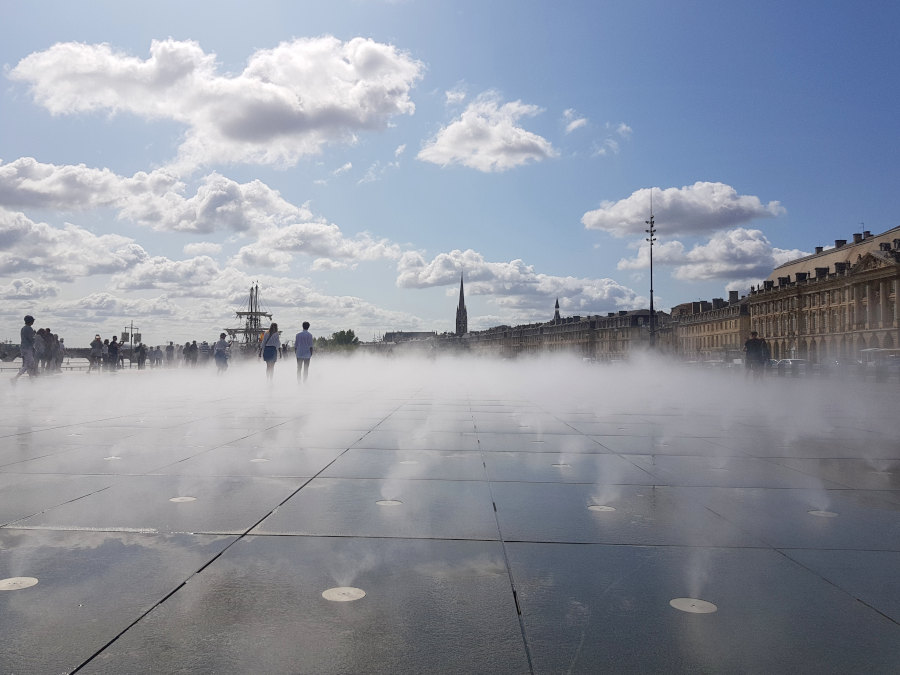
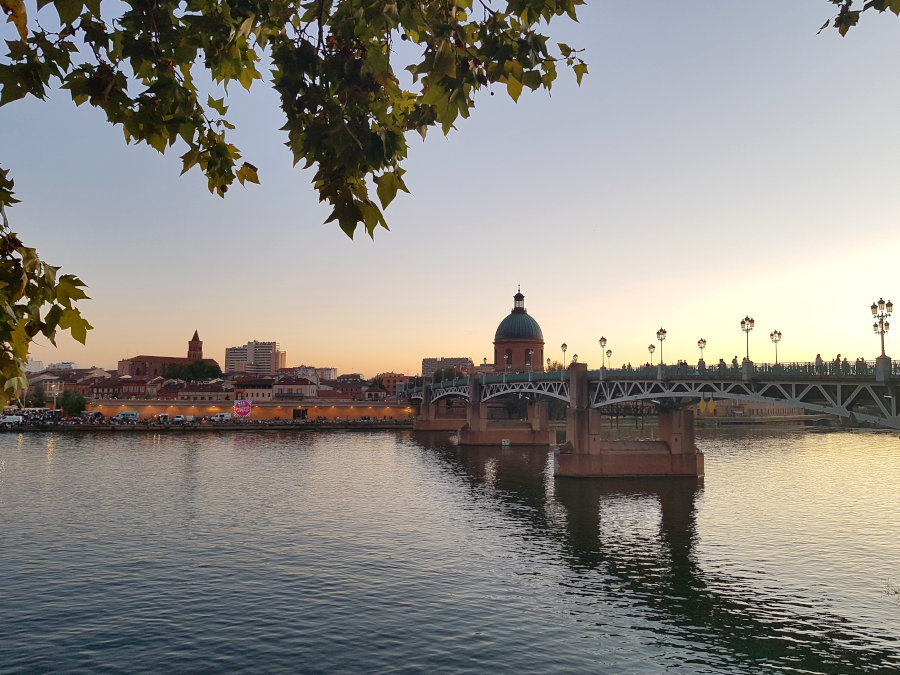
Best time to visit the Dordogne
If you want to benefit from the Mediterranean climate, the months from June to September are the best. In midsummer from July to August there are many tourists on the river. Many beautiful gravel banks for wild camping or campsites near the river are quickly occupied. In the months of June and September, the advantage is that there are considerably fewer tourists in the region and the weather is still very stable. Temperatures above 68°F (20°C) are very common in September and offer actually the best paddling conditions. Only at night it can get colder in September. May and October could also be an option for weatherproof paddlers and campers, but most campsites have already closed.
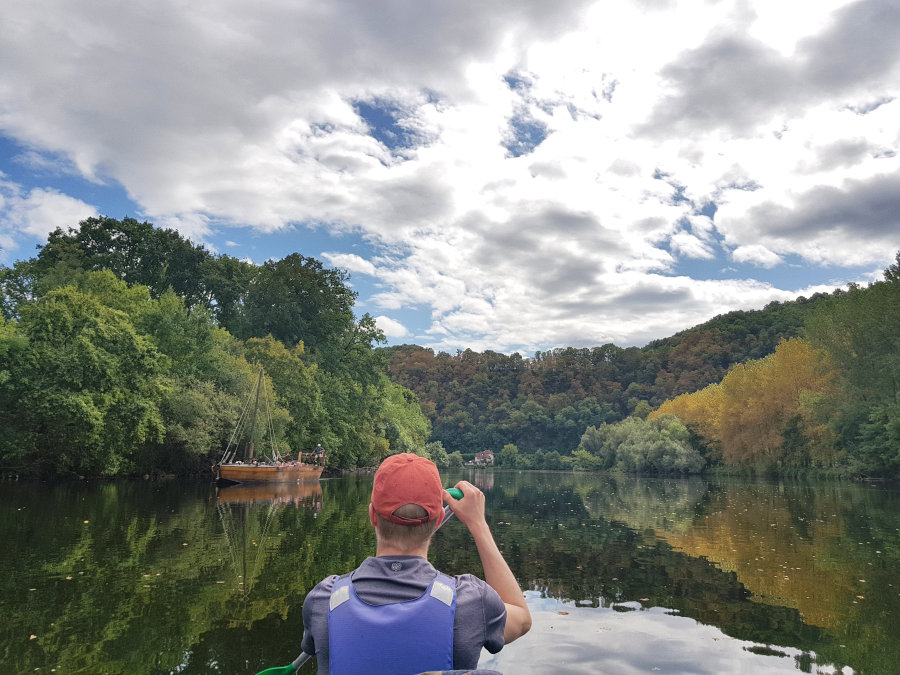
We did our canoe trip on the Dordogne in September and can only recommend this period. The weather was very good. We had rain only once during the night and the temperatures were between 68°F and 79°F (20°C and 26°C) during the day. At night the temperatures sometimes went down to 45°F (7°C) and good camping equipment was therefore very important. But we really enjoyed the autumn colours and the silence on the river. Of course, you should also consider that the days in autumn become shorter.
Accommodation in the Dordogne
Even if you are out in nature for several days, camping is not a must. The possibilities range from wild camping on a gravel bank to an upscale hotel.
Wild Camping
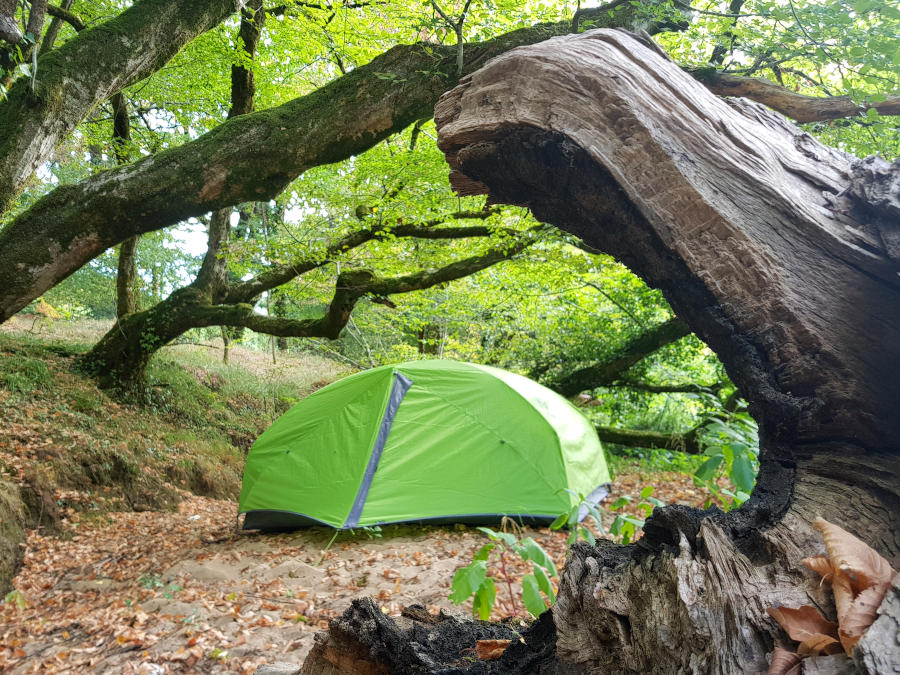
Wild camping is not allowed in France, but one-time overnight stays on the riverbank is tolerated in the Dordogne. You should be careful not to pitch your tent on a private property or too close to a village. Free and flat areas on islands and gravel banks indicate suitable places. Do not camp too close to the water or just a bit above the water level of the river, as the water level can rise quickly, especially on the upper course of the river, due to the regulation at the weir in Argentat. In the high season, however, you should not rely on free spots for wild camping, as these are very popular and therefore quickly occupied.
Campsite
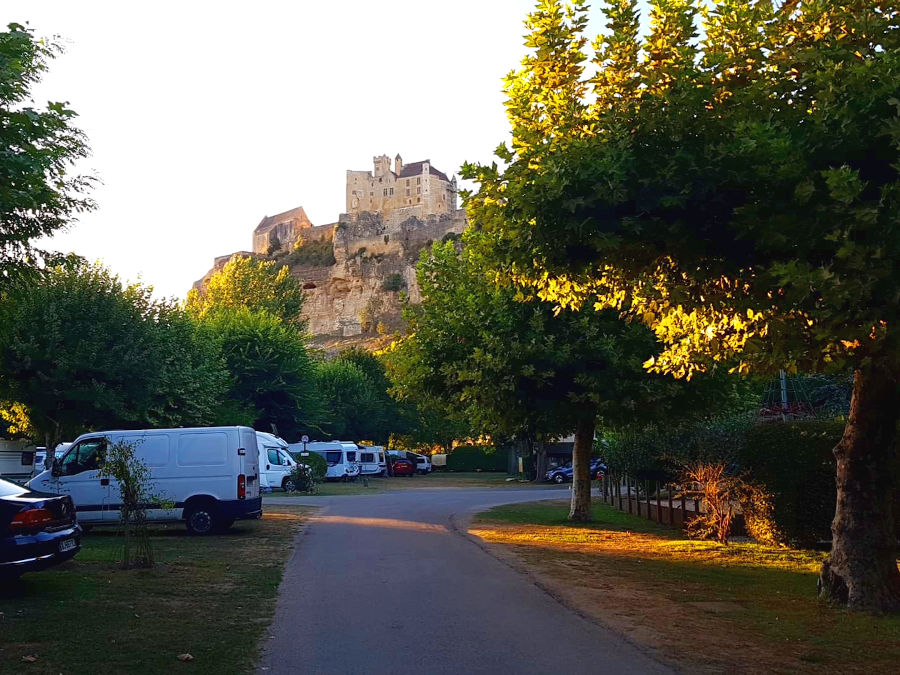
Most paddlers on a multi-day trip stay overnight at one of the many campsites along the river. Since there are so many campsites, it is easy to find a campsite every night. Most of them are right on the shore, where you can leave your canoe. But same here, in the high season the popular campsites are quickly full and you will not always have free place choice. In addition to hot shower, most campsites also have a small restaurant, a swimming pool and even a small grocery store.
Hotel
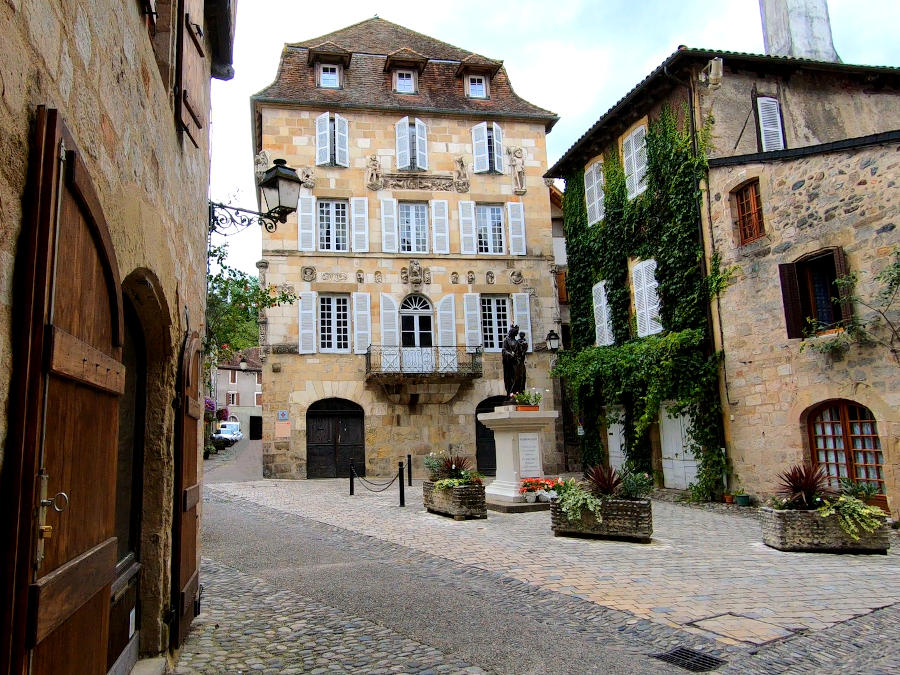
Those who are not a big fan of camping but prefer to sleep in bed, can take a Bed&Breakfast or hotel in the many villages for a reasonable price. As these are often smaller accommodations with few rooms, an early reservation is recommended. You only have to check if you can leave your canoe on the property of the hotel or if you can let it safely on the shore. Most accommodations are in idyllic villages and in lovingly furnished country houses, which convey the charm and character of the region very well.
We were out in the low season and camped 5 nights on the river bank. This gave us complete flexibility in planning our tour, as we were able to stop at any time. Due to the few paddlers on the Dordogne in September, we had almost always free choice of place and the little islands or gravel banks for us alone. This was definitely a highlight of the Dordogne tour for us, because you could enjoy the wonderful views on the river in complete peace. Only on the last evening in Beynac-et-Cazenac we stayed overnight on a campsite, as wild camping close to villages is not really tolerated.
Canoe rentals at the Dordogne river
There are countless canoe rentals on the Dordogne. Some are more specialized in day trips and others in multi-day trips. For multi-day tours in high season you should book your canoe in advance. With most canoe rental companies, the car can be parked on their property. The return transport after the tour takes place in minibuses back to the canoe rental.
Explorando – Canoe rental
On this tour we didn’t take our own boats with us, but rented a canoe from the rental called Explorando. In addition to the numerous other rentals in the region, this one convinced us above all with a friendly and flexible service as well as the high-quality boats.
Usually you will also get dry bags and containers. Some rentals also have camping equipment. We have chosen the smaller company Explorando, which specializes in tours lasting several days. Thanks to the good equipment, the flexible and friendly service we can also recommend this canoe rental company.
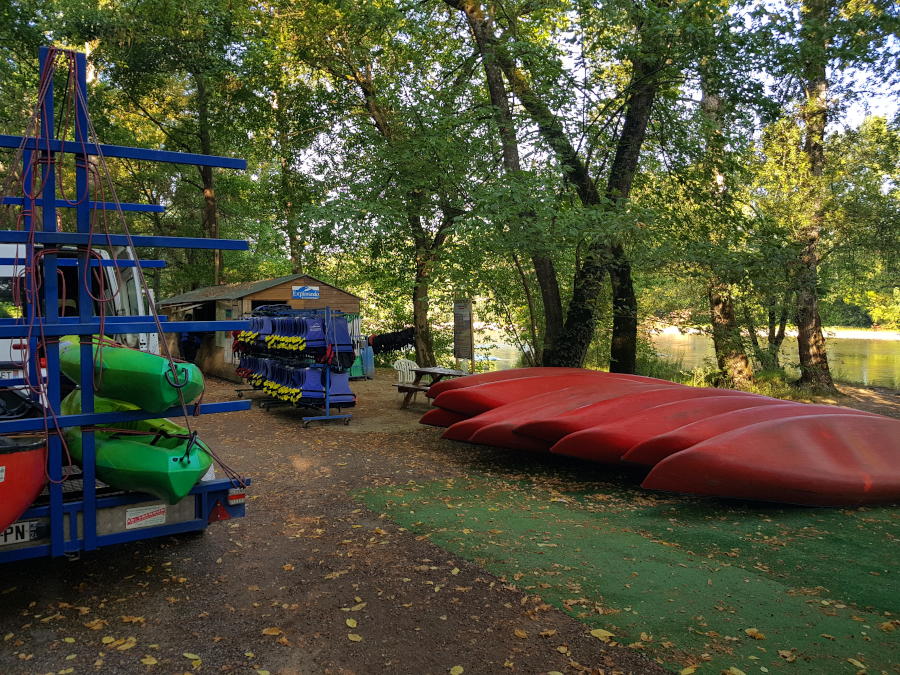
Our canoe tour from Argentat to Beynac-et-Cazenac
We have devided this canoe tour in the following sections:
Day 1 – Argentant to Brivezac
Day 2 – Brivezac to Reingues
Day 3 – Reingues to Montvalent
Day 4 – Montvalent to Le Treil
Day 5 – Le Treil to Monfort
Day 6 – Montfort to Beynac-et-Cazenac
Day 1 – Argentat to Brivezac
The evening before we arrived in Groléjac by car and spent the night in a small hotel. The next morning at 9:30 am we met at the base camp of the canoe rental company Explorando. We loaded our things and provisions for the next days into the minibus and went for an approximately two-hour trip in the minibus to Argentat. We also got a small river map from the canoe rental company, which was very helpful by the way. All important places and spots were marked, e.g. strong rapids and how to avoid them best, some campsites, restaurants and castles.
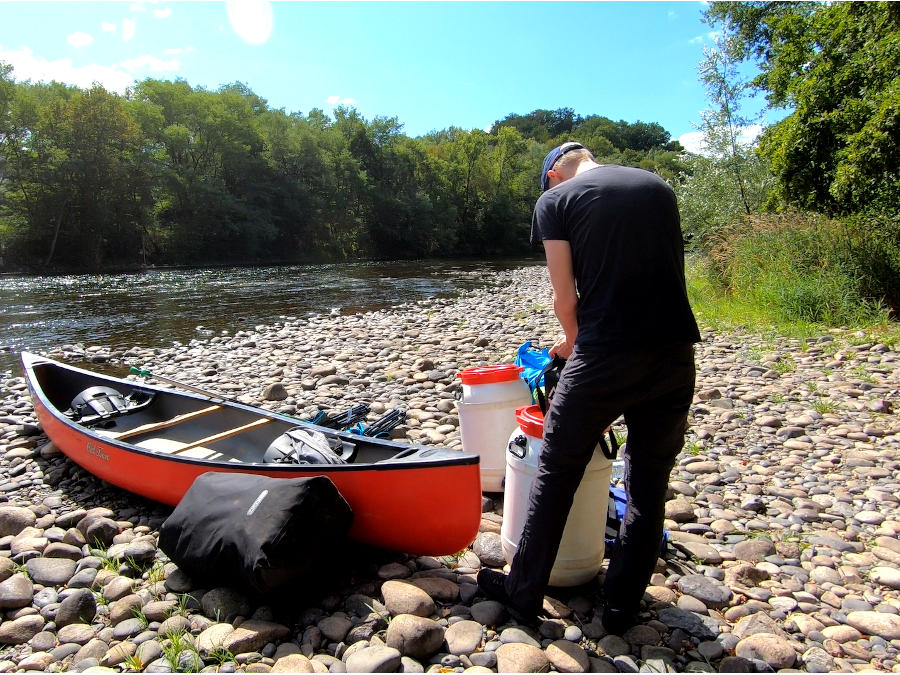
Starting point of our tour was then at the camping site “Camping Europe”, just before the rapid Malpas (the term “mal passage” means bad passage). Here we loaded our boat and put it into the water.
The rapid Malpas was quite challenging. An island divides the passage, whereby both sides are passable. The passage on the left side is easier, but also this can be quite bumpy and lively. Due to the lower water levels in September, the current was less fast than in summer. But when the water is low, it is not easy to find the way through because some rocks are blocking the course.
So we catch a rock quite badly and the boat swayed and runs full of water. We already have the capsizing before our eyes, but in the end we can just save ourselves with the full boat to the shore. Since the water level is very low at that time, capsizing at this level would not have been a dangerous undertaking. Paddle beginners should rather start their tour after this rapid. In summer, when the water levels are higher, there is even the volunteer fire brigade here to help capsized paddlers.
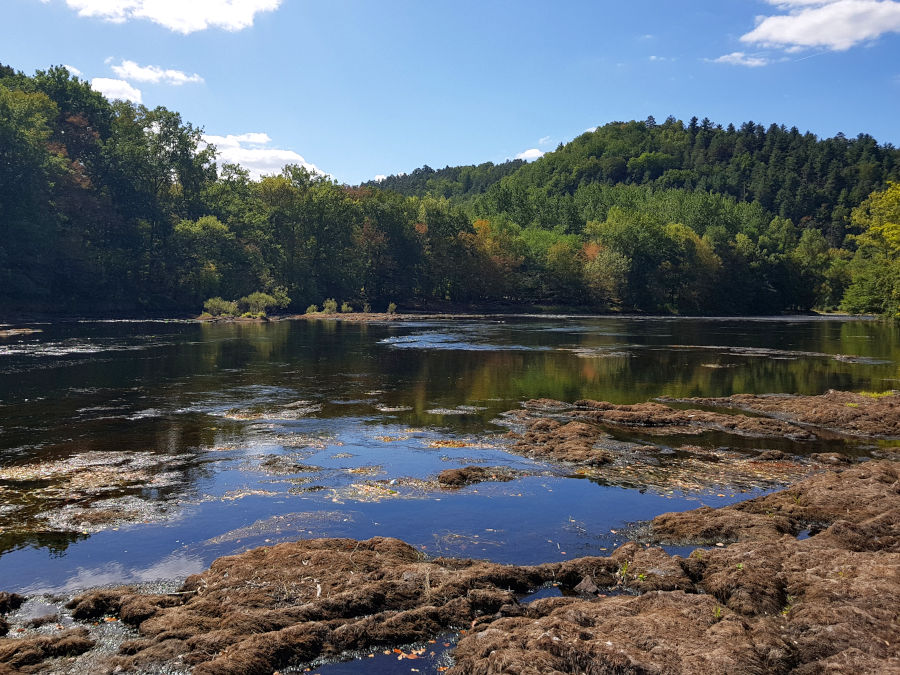
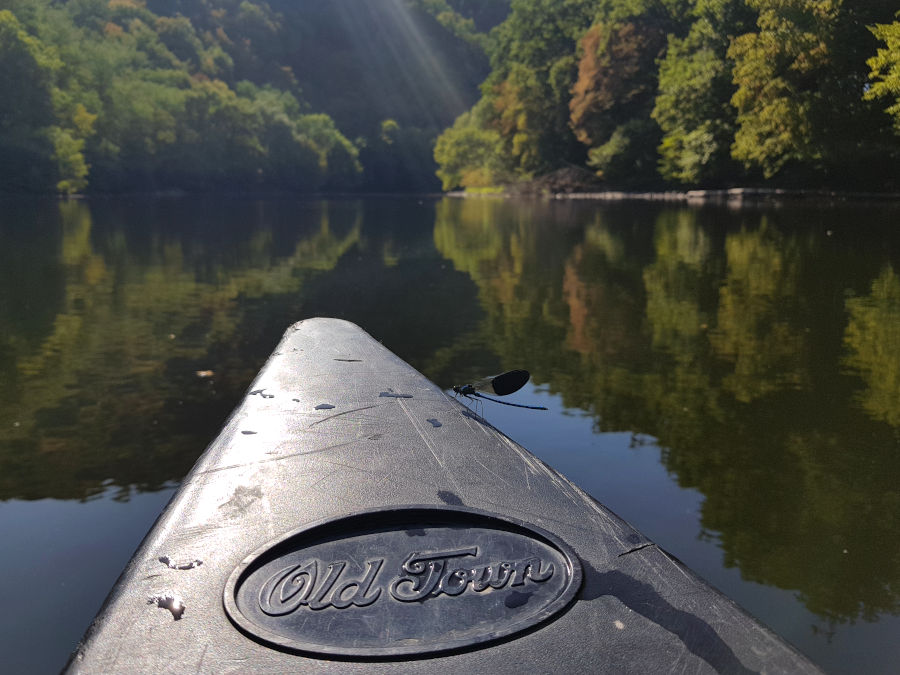
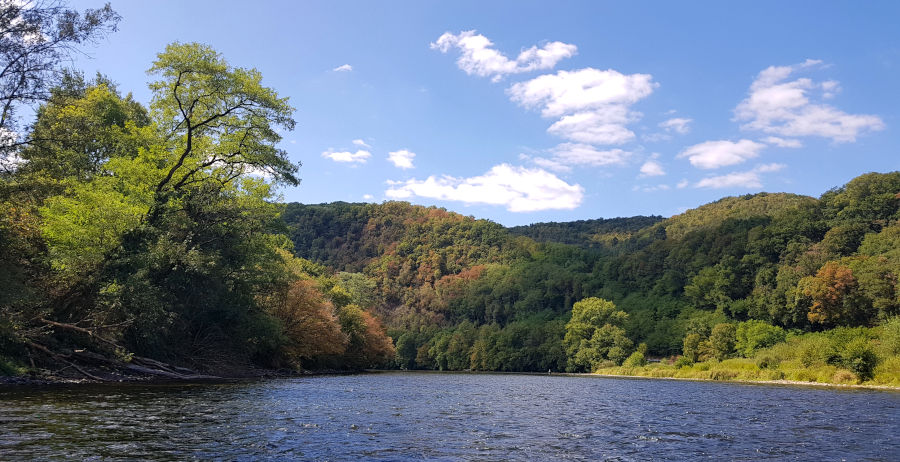
After the rapid Malpas we continue through parts with fast currents. Most of them can be passed without any problems and are more likely to make for rapid progress and are quite fun to drive through. A few places, however, require a little more attention, as rocks or stones sometimes block the course of the river and have to be avoided. Especially when the water level is low, ground contact with a fully loaded Canadian is not uncommon. Here you should always follow the main current, where most of the passages are best. After some time the course of the river becomes quite calm. However, the basic current is sufficient to drift and still make good progress.
Numerous anglers standing in the water and grey herons characterize this section. On this day we meet only two more paddle boats and can therefore enjoy the river hike in the best weather. Already during the first longer break at the river bank we realize how good the purchase of the folding camping chairs in Bordeaux was. There is nothing better than to put up your camping chair in the sunshine on a beautiful gravel bank. Once you’ve sat down, you sink into your chair at the sight of the beautiful nature and would like to linger for an eternity.
At Brivezac we meet a rather strong rapids again, where we decide to look at it beforehand in order to find the best way for the passage. If you hear a strong noise from a distance and you are not sure how to get there, it is always a good idea to dock in advance and take a look. Shortly after the passage, the first day of our tour comes to an end and we head for a beautiful shore where we finally pitch our tent.
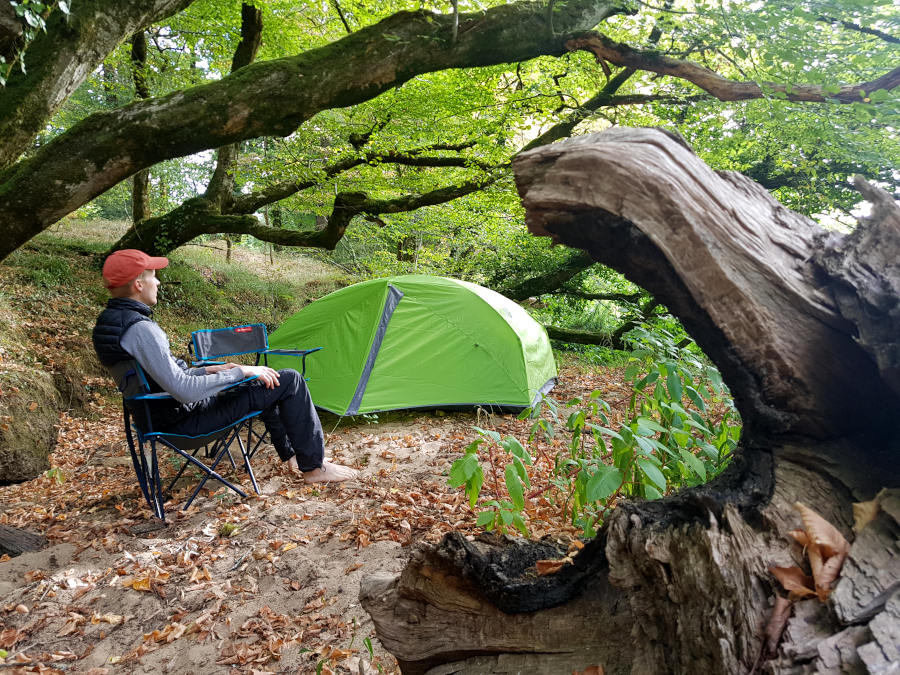
Day 2 – Brivezac to Reingues
After the first night’s stay, we continue our journey towards Beaulieu-sur-Dordogne, the first major village, where it is definitely worth stopping to explore and to have a coffee. But before we reach this place we discover such a beautiful shore where we simply have to take another break. It is located on the right bank as soon as you see the first house of the village from a distance. From here you also have a really good view of the river. The place is also perfect for swimming. Unfortunately, we didn’t reach this spot the night before. Because we would have pitched our tent here in any case. Anyway, we use the warm midday sun to cool down in the river and prepare our lunch.
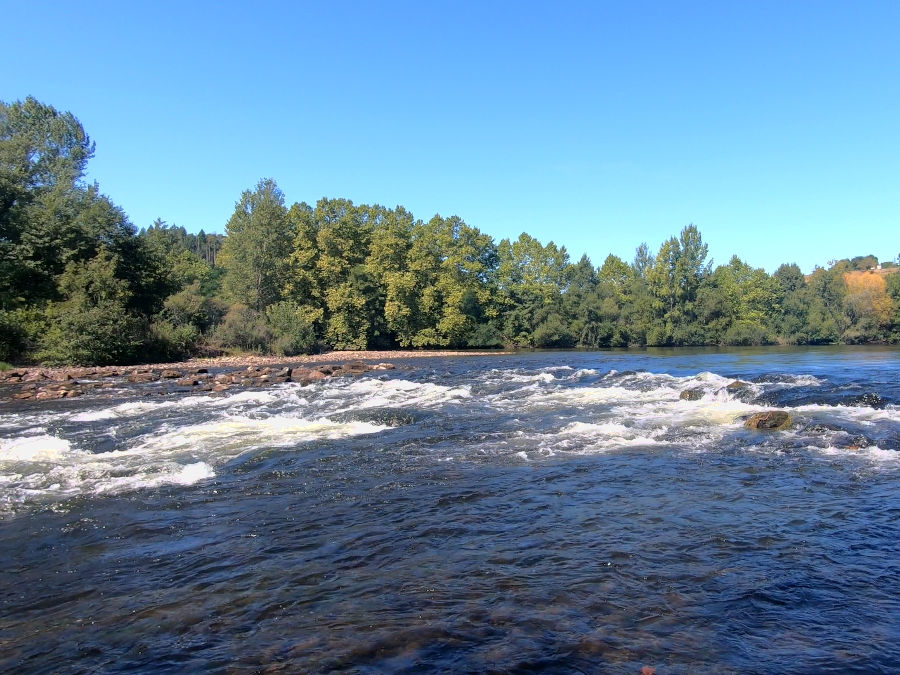
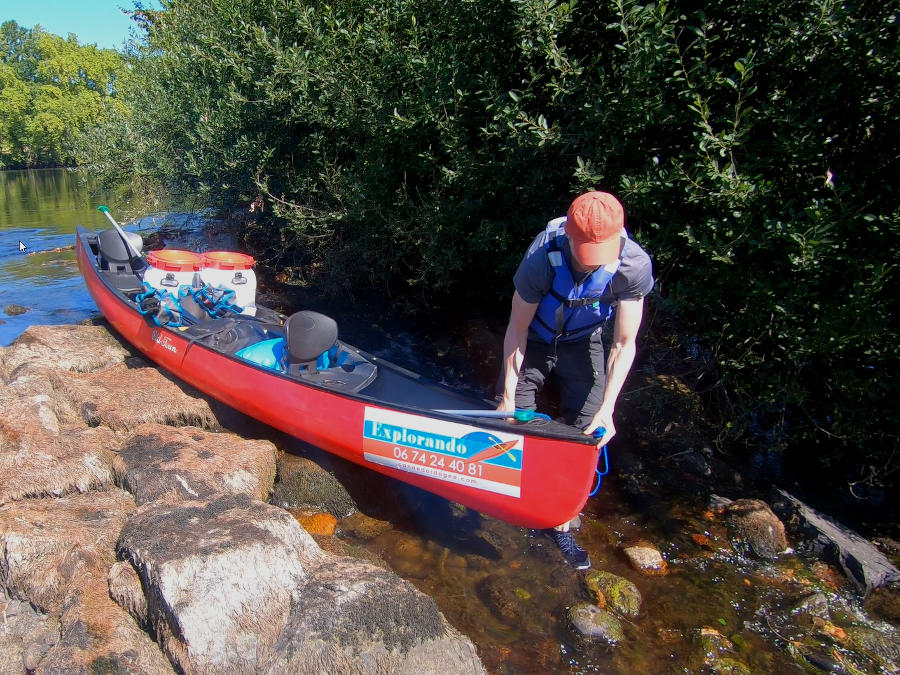
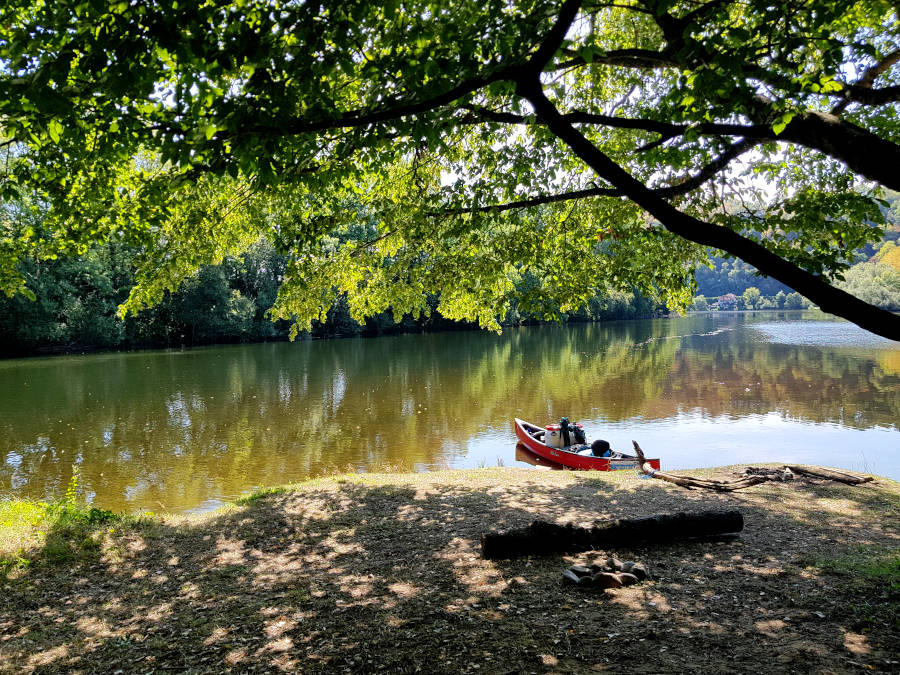
At Beaulieu-sur-Dordogne you find a weir, which can’t be passed by canoes. But it can be bypassed on the left via a branch that can be reached by a water slide. Those who want to have a look at the village should first land on the right bank close to the church. Beaulieu-sur-Dordogne is indeed not as spectacular as other idyllic villages that will still be waiting for us, but it already gives a nice first impression what the region has to offer. Moreover, there is a small supermarket where you can also refill your provisions or buy something that you might have forgotten before. Beside a walk, also small restaurants and cafés invite to a pleasant break.

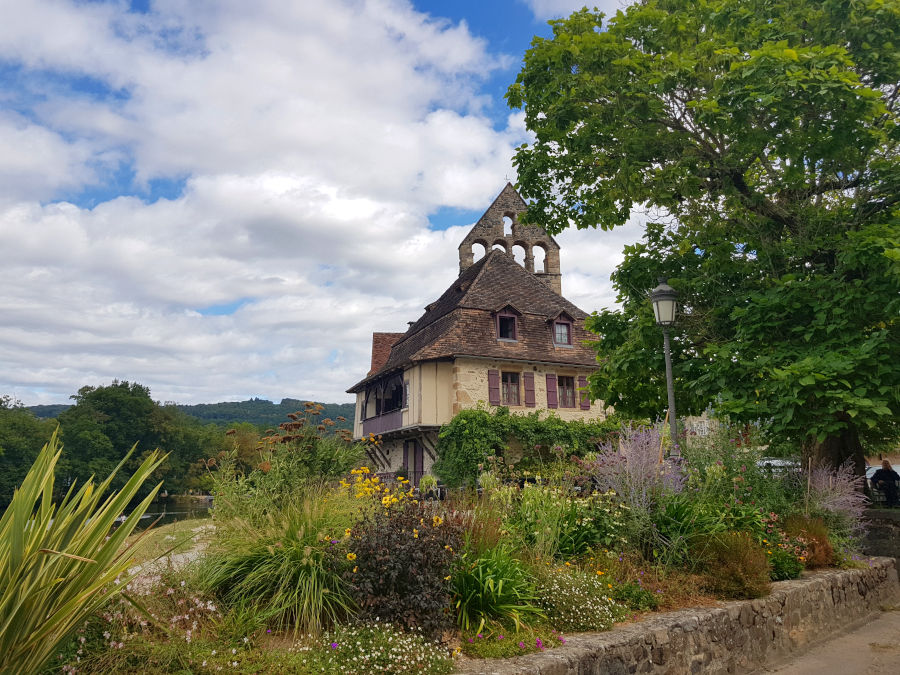

After Beaulieu, the Dordogne flows mainly through pasture land and the next thing we notice is a big old wall on the right bank of the river. Behind this wall there is a castle called Château d’Estresse, which is not visible from the river. By chance we see that there is a big ladder on the river bank. The curiosity persuades us to dare a view over the wall in order to catch some glimpses of the castle. The idea with the ladder worked well, but unfortunately we didn’t see the castle from there either. Thus, we are not able to view the first castle on our canoe tour. But this should change soon.
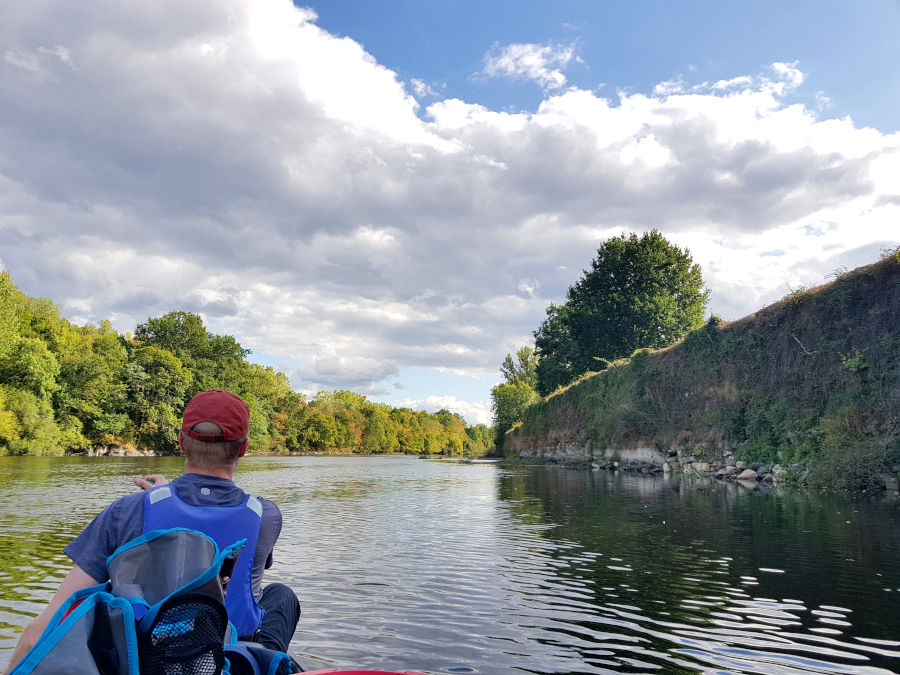
Because not much later, what a canoe trip in the Dordogne is so famous and popular for follows: the first castle which is placed in the landscape like in a fairy tale book. The castle of Castelnau-Bretenoux is a few miles from the river. If you have a little more time, you can land on the riverbank and walk there to visit it. We decide not to visit the castle. But as it is enthroned on a hill, it can be seen quite well from the water for some time and we enjoy the views.
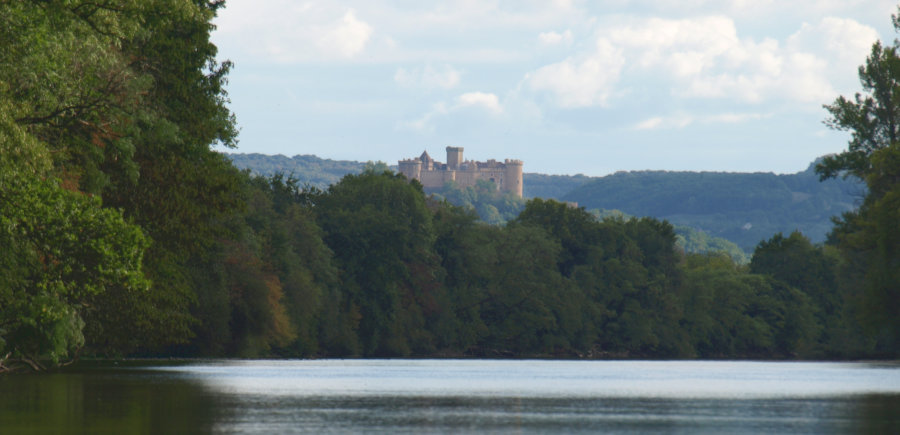
Then follows a larger island, which offers numerous gravel banks with good resting places. After this island we land on the left bank near the small village of Reingues and set up our camp. Since the river makes a bend at this point, we had a really good view of the river course in the evening.
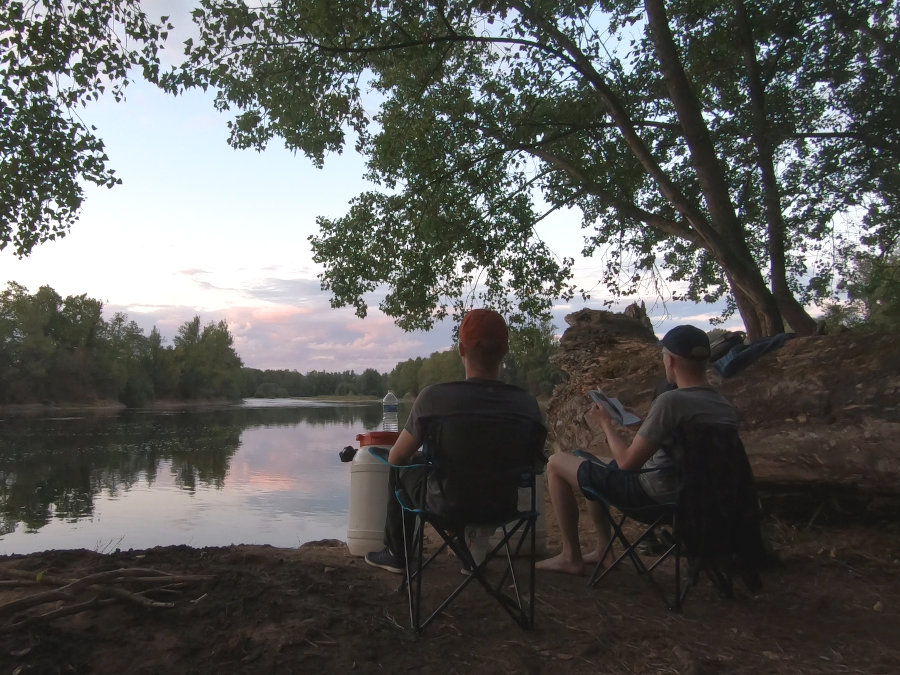
Day 3 – From Reingues to Montvalent
The next morning we continue along small villages with the destination Carennac. This village was awarded as one of the most beautiful villages in France. If you want to visit this medieval village, you should keep to the left before the village and follow the tributary of the river, because this is the only way to get directly to Carennac. We find the trip through the canal particularly varied. This small section, which is very narrow and covered with many trees, strongly reminds us of our paddle tour in the Spreewald in Germany.
After about 1 mile on the side arm we reach the city centre. Here we enjoy the walk through the village in wonderful sunshine and summery temperatures. Carennac is indeed a picturesque village with a lot of charm. A detached tower in the centre of the village is a popular photo motif. Today it does not fulfil a great function anymore, since it’s used to be a stair tower of a former building. We then stop for lunch at the Priearé Restaurant. Here we had a very good meal and can highly recommend it.
By the way, those who want to exchange the camping in wild nature with a soft bed in a romantic village for one night are right in this village. Looking back we have to say that Carennac was one of the highlights of the Dordogne tour for us. So, it’s definitely worth spending some more time at this beautiful place.
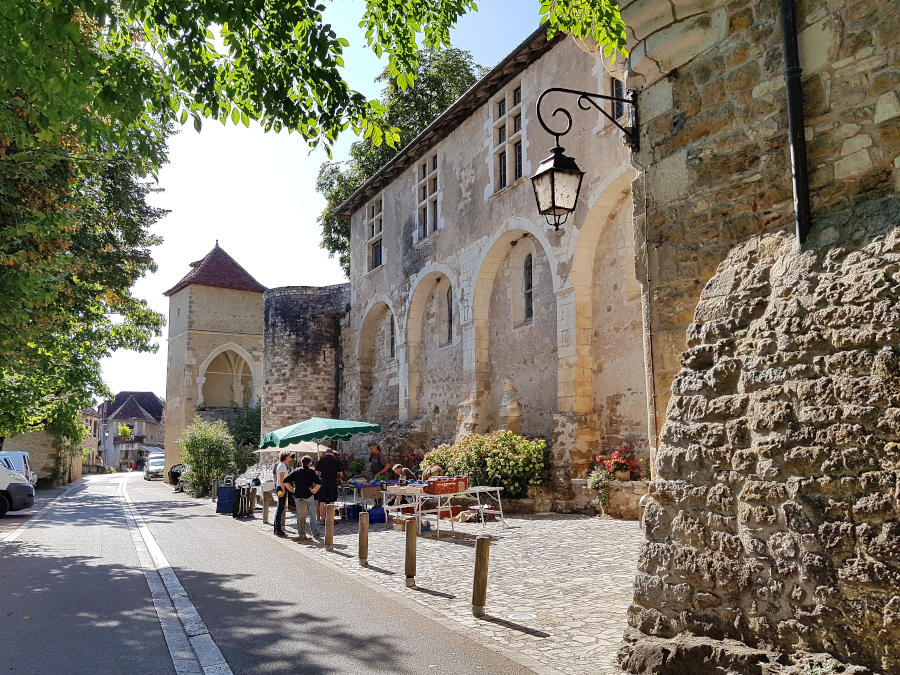
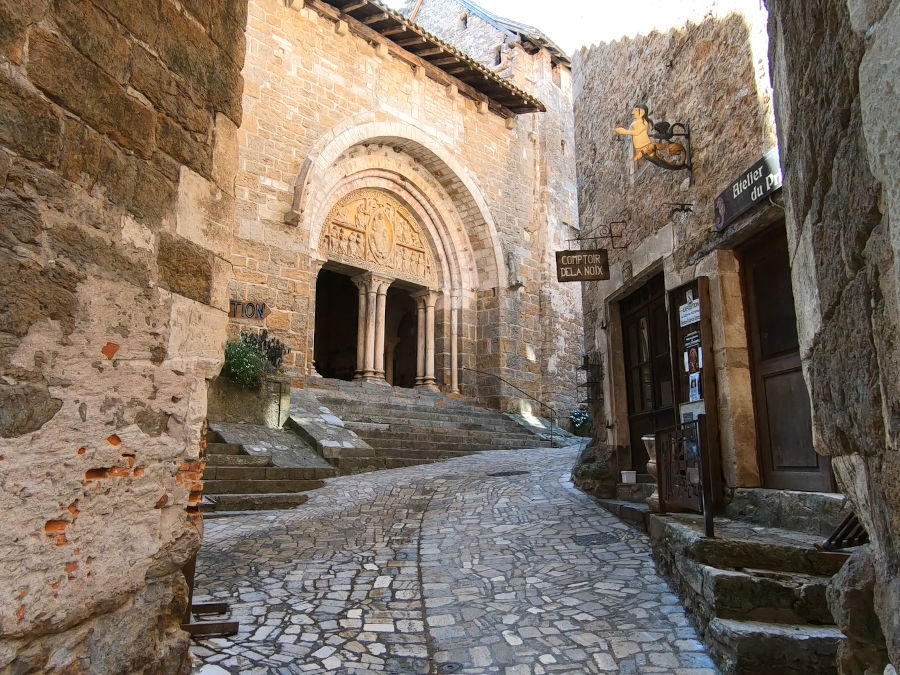

To get back from the side arm to the Dordogne you have to use a water slide. But the water level is so low that we have to pull the boat down. On the main river there are a few rapids shortly afterwards where you have to be careful to get through safely. Since the sun is so nice and warm that day and we still feel full of midday, we soon find a spot on the bank to put up our hammocks. With so little hustle and bustle on the river and such good weather, the camping chair and the hammock become one of our best friends on this trip to simply relax and unwind.

As we continue our journey we notice how slowly huge rock faces are piling up, which will determine the river landscape for the next few miles. The view point “Belvédère de Copeyre” offers the possibility to gaze at the Dordogne valley from above. So, we land on the gravel banks below the view point. Unfortunately, there is no footpath up to the view point but only the path on the road. But here, you have to pay attention very well, as the road is quite busy. The curves and the gradient of the road make it difficult for car drivers to see it in some places. We would not recommend this side trip to families with children. But once arrived at the view point, you have a really excellent view that takes one’s breath away.
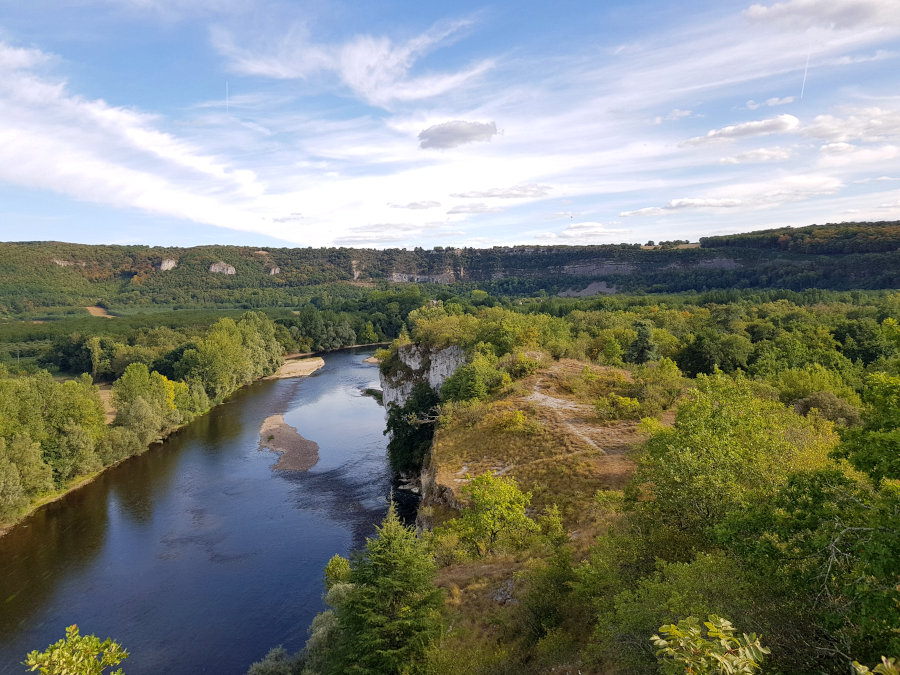
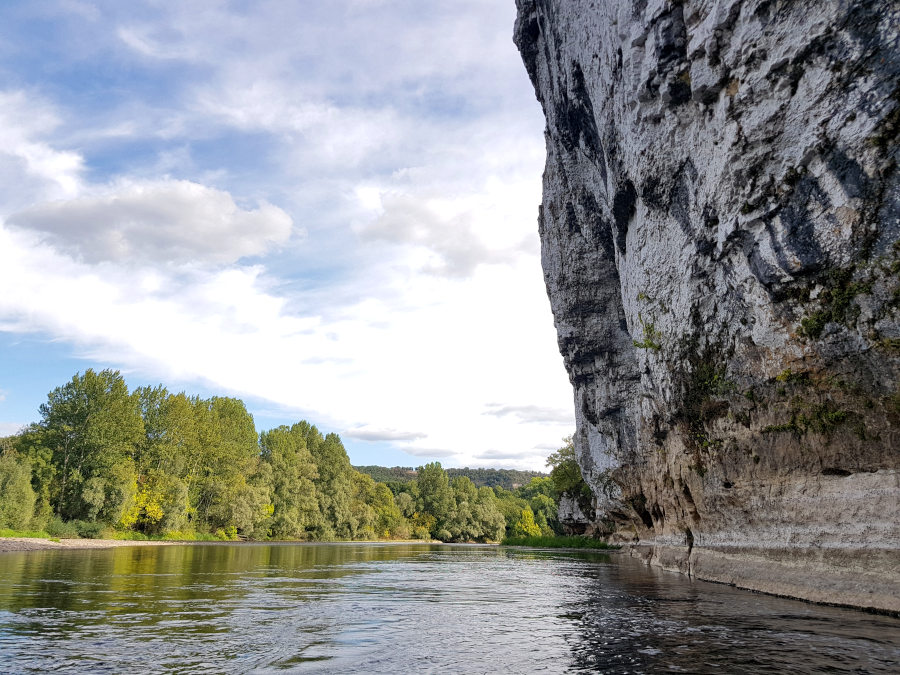
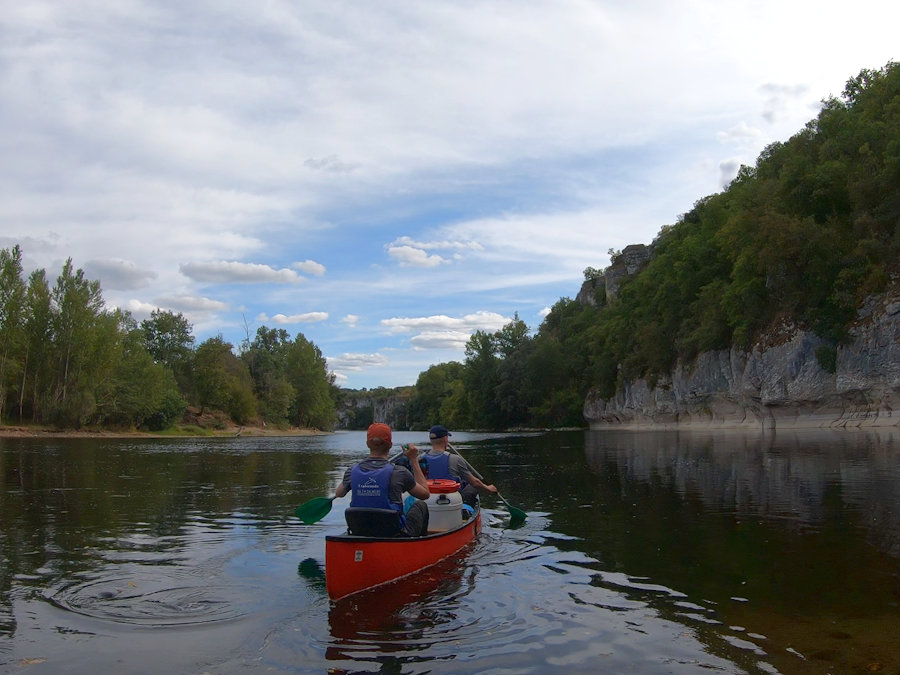
With just as much astonishment we finally paddle on, because the exciting rock formations create a very special scenery in the evening light play. At the curve of Le Port de Gluges we have another break, as the view of the rock walls is very impressive. Then we continue paddling and at dusk we find our perfect camping spot at a curve close to the village Montvalent. With the last rays of the sun and the lonely silence, the autumn colors of the trees on the shore seem really magical. The gravel bank is very long and numerous fireplaces show that many canoeists regularly stay overnight here. We have the whole gravel bank to ourselves that evening, sitting with campfire on the riverbank until late.
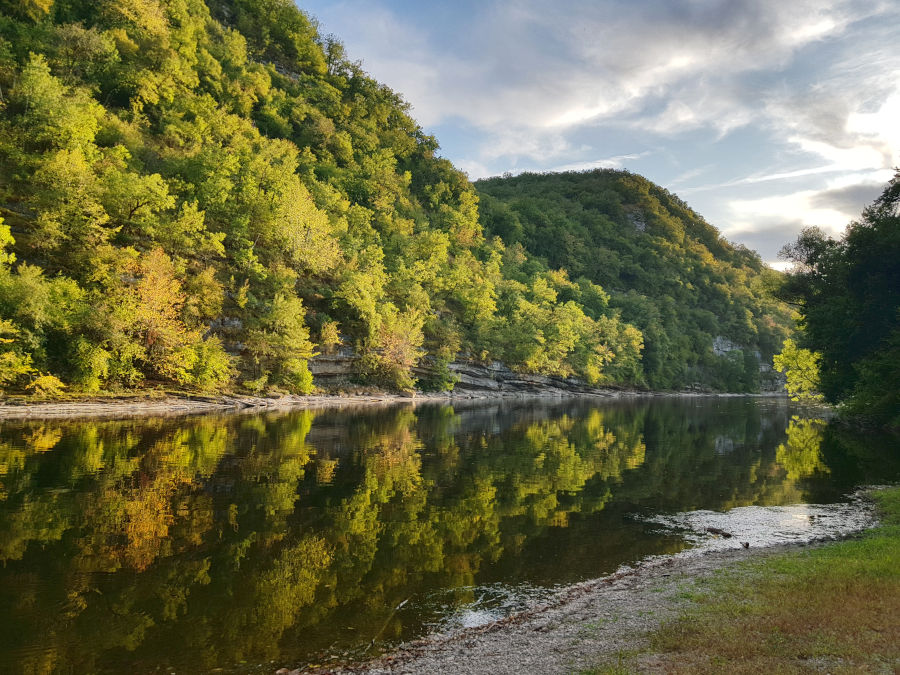
Day 4 – From Montvalent to Le Treil
When we open the tent the next morning, we quickly notice that the warm autumn atmosphere of the previous evening has changed into a morning autumn cold. The temperature is still far below 50°F. We decide to quickly take down our tent and stow our equipment in the boat. Off we go with strong paddle strokes to warm up and soon we catch the first sunrays.
At the latest when it gets warmer the hunger and the appetite for a really good breakfast seizes us. A look at the map tells us that the village Saint-Soizy is not far away and there is supposed to be a shop with fresh French baguettes. We decide to land on below the motorway bridge and then buy our well-deserved breakfast in the nearby town centre.
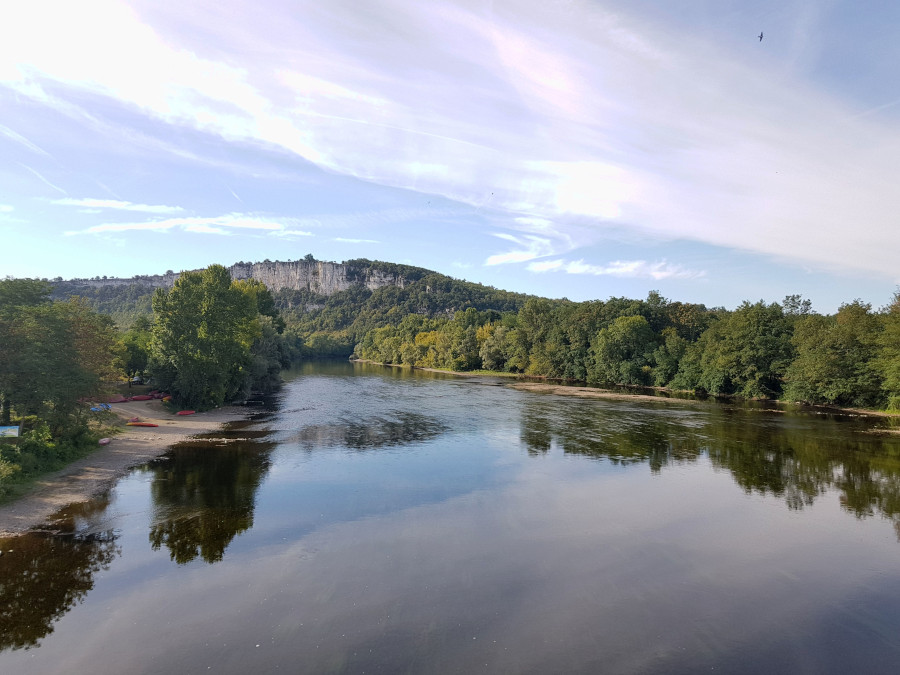
Back at the boat, we paddle a few hundred metres further on, then leave the motorway bridge behind us and have breakfast on the bank. The small breakfast break turns into a quite extended break with cooling in the river at meanwhile summerly temperatures.
Then we continue to the village of Lacave, where we want to take a break to visit the stalactite cave there. Either our map on the mobile phone and our river maps show us the wrong way or we clearly got the wrong way. At the end, we meet two donkeys on a meadow that want to tell us that surely there is no stalactite cave to be found there. So we leave the shore again without having found the cave, knowing that soon another one is waiting for us.

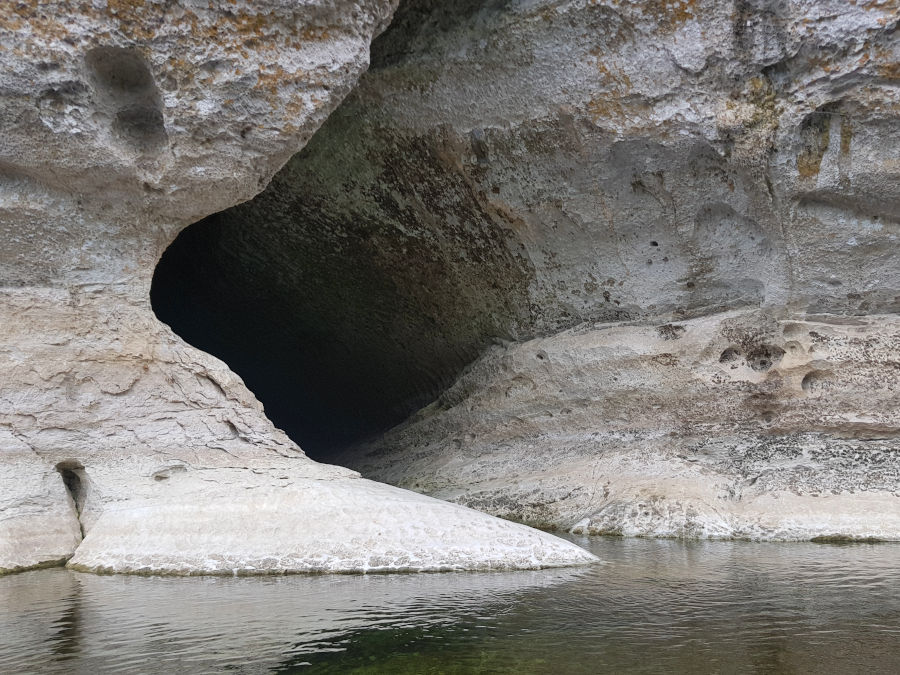
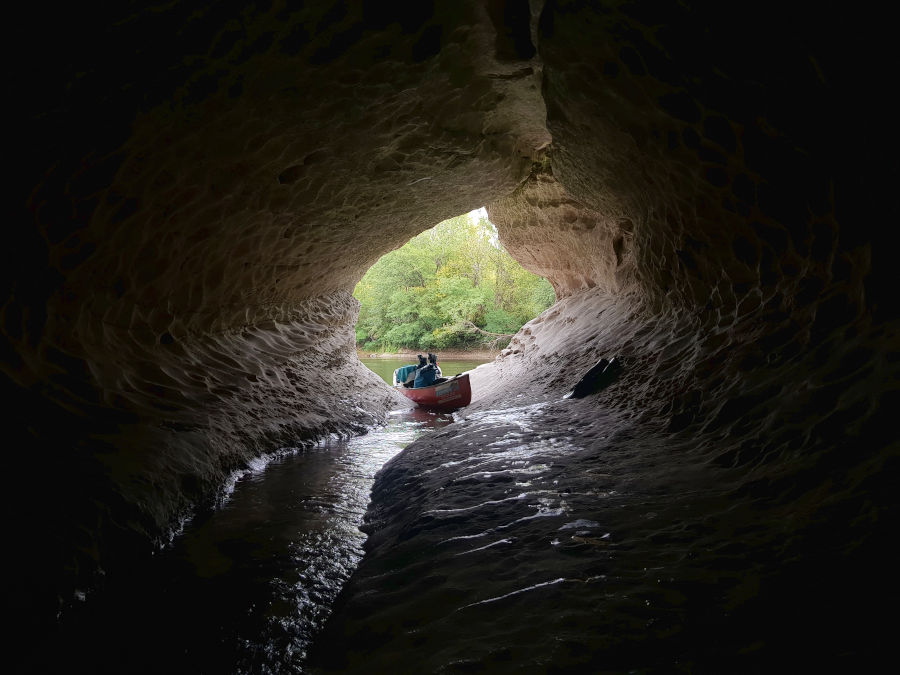
Because if we continue paddling from Lacave, we only have to keep left at the rock face and keep our eyes open for a cave. Shortly before a house lying on the slope the entrance to a cave finally appears in the rock wall. If the water level is sufficient, you can even go in by canoe for a few meters. At our place the water level is too low and we have to get out to continue on foot. At the end there is a water basin where you would only get further with diving equipment. Nevertheless the cave is worth seeing and gives a little adventure feeling.
After we finally got our little cave experience, we continue paddling and as next, the Château de la Treyne tempts us to take a break again. It is located on a rock and really nestles into the landscape. We grab our camping chairs and take a refreshment break. By the way, there is not much to visit at the Château de la Treyne, as it is nowadays a luxury hotel.
Finally, the Dordogne gets a little further and the shore regions flatten. We already see the next castle from a distance, the Château de Lanzac, which is also privately owned. With the grazing cows in front of the lonely castle and the absence of any modernity, we almost feel like being taken back a few centuries ago.
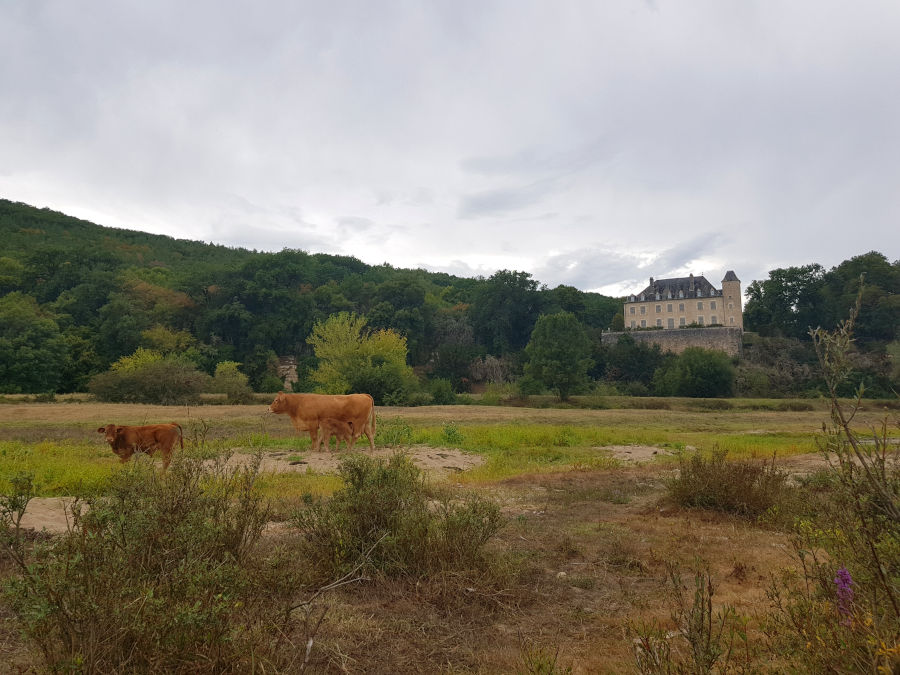
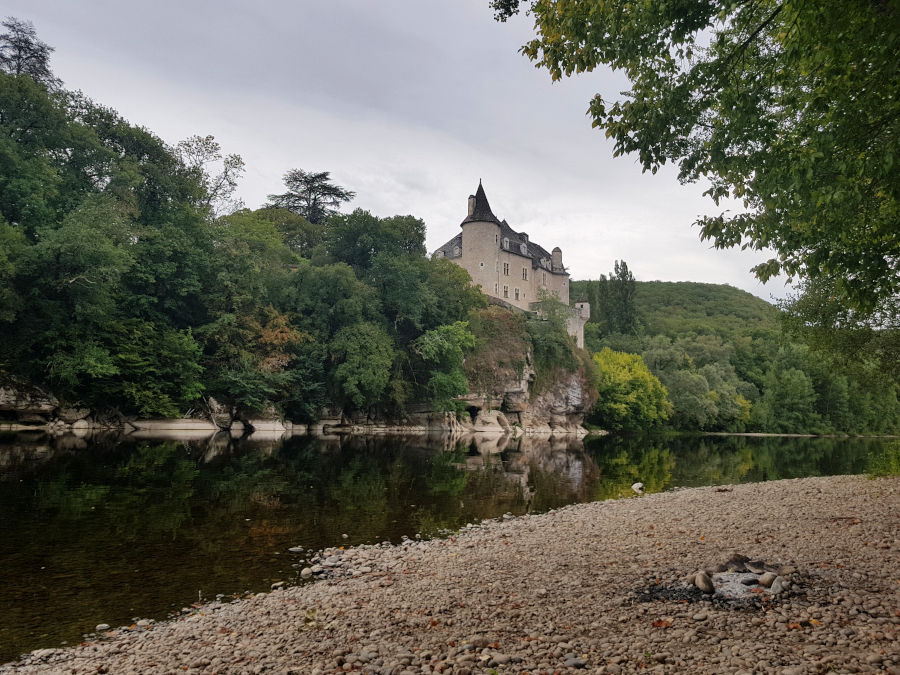
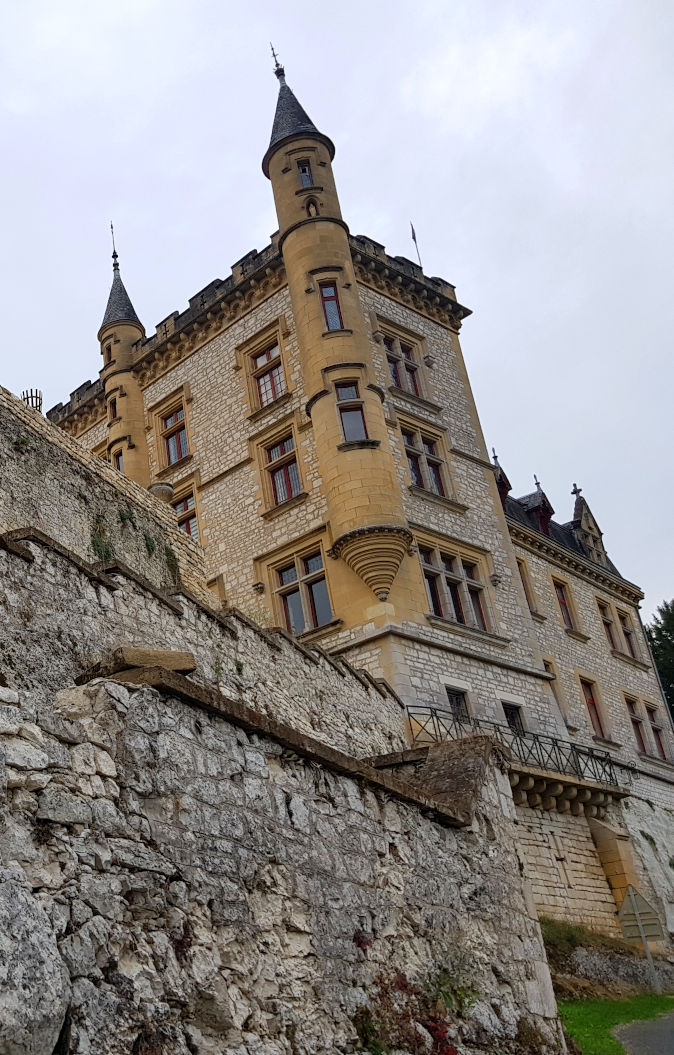
Soon the only real town on the Dordogne follows: Souillac. The town with its 4000 inhabitants does not have the same charm as the many other medieval villages we have seen before. Souillac is rather a traffic junction and the modern life dominates the townscape. But the city is ideal for refilling your provisions or going out for a meal. As we still have plenty of provisions, we do not stop at Souillac and continue paddling.
At Cieurac we see a castle again, which is also privately owned and has no official name. Nevertheless, we land on and walk on the hill of the castle, which is located in the middle of the village of Cieurac. The castle is also easy to visit from the outside and its architecture and location is really impressive. The silence in the village and around the castle almost creates a mystical atmosphere, which is perfect for a cloudy evening walk.
As the day is coming to an end, we are looking for a suitable place to pitch our tent. For the first time we pass a place that we like so much that we would have loved to pitch our tent there. But two other canoeists were faster and have already taken the place. Therefore we decide to paddle a few more miles for the next day ahead and finally we find what we are looking for on the island after the camping site “Camping La Borgne” in Le Treil. In the night it rained a lot, but this was also the only time during the whole tour.
Day 5 – From Le Treil to Monfort
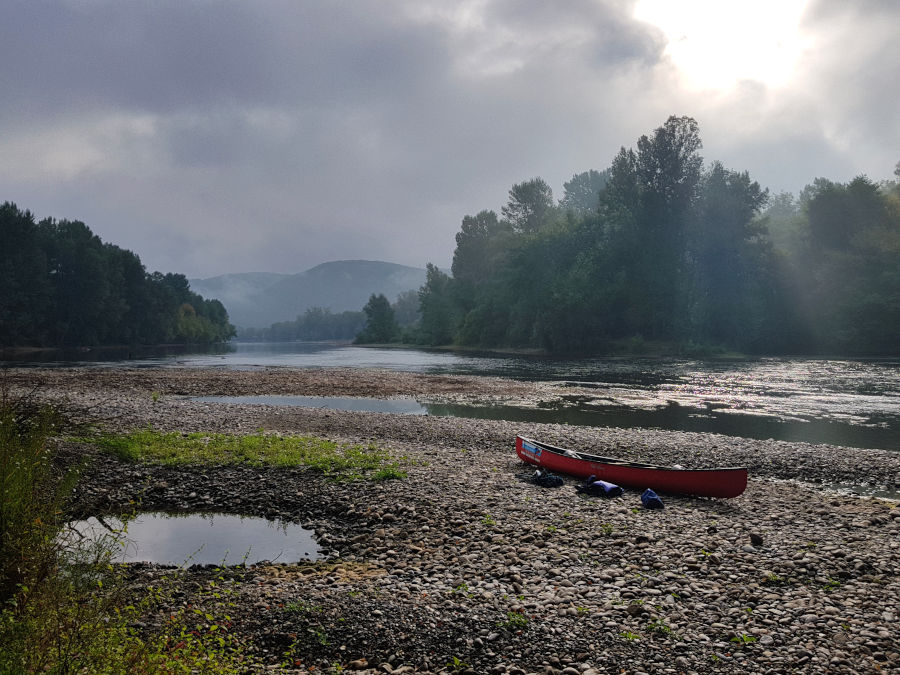
The next morning is quite cloudy at first and we can see everyhwere the wetness from the rain of the night. We set off towards Groléjac and paddle through almost without any break. We like the cliffs in front of Groléjac, which are really stunning.
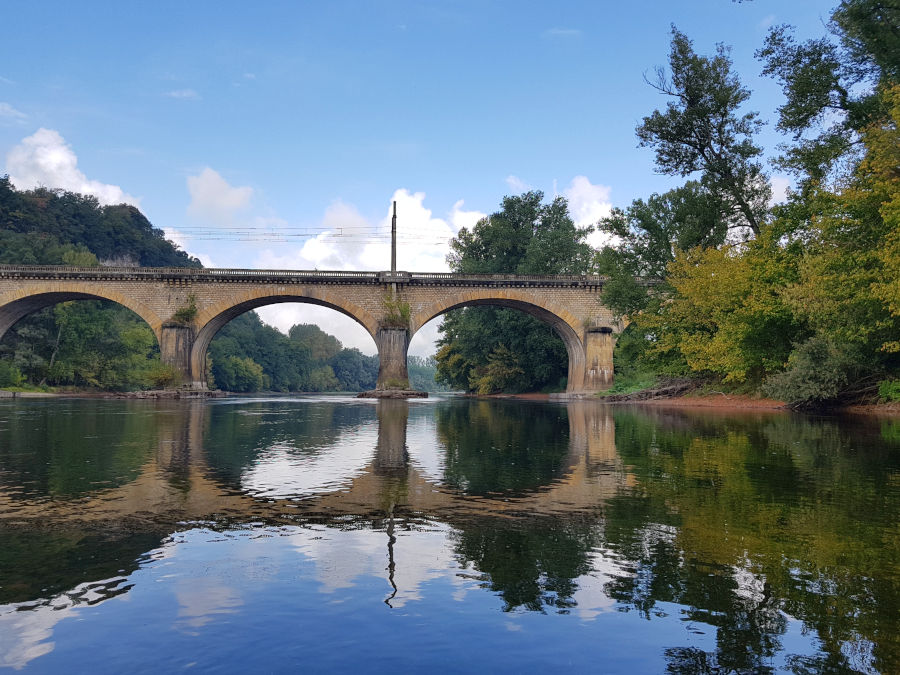
After we have refilled our provisions in the afternoon, we continue and soon, the Château de Montfort follows. The bend where the castle becomes visible is also very beautiful from the nature and we decide to have another break. Here, you can’t just paddle by but you have to stop. Finally, the break turns into an overnight stay at the same place, as we are sure that we can’t find a nicer place for camping. A small sand beach, a direct view on the castle and a protected area for the tent. It could not be better. Instead of pitching our tent, we finally put up our hammocks. Sleeping at least once in out hammock was one of our goals for the canoe trip.
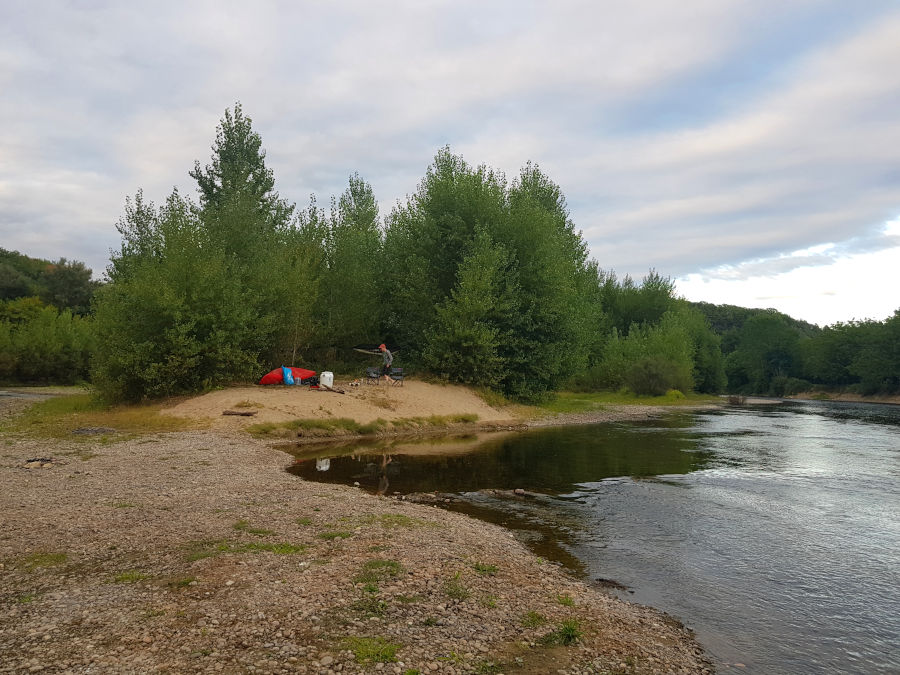
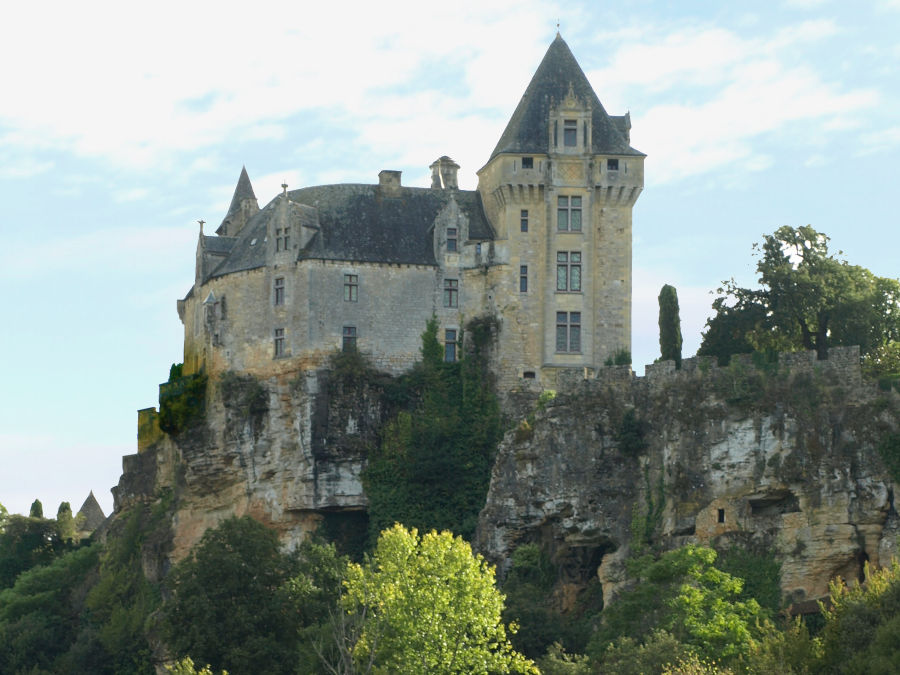
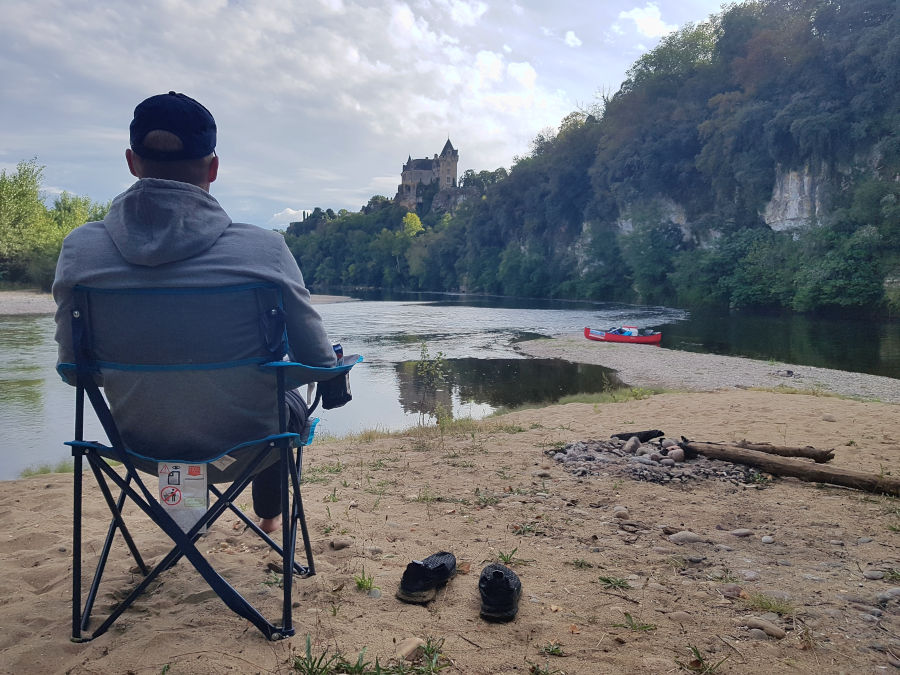
So we sit this evening again very long in the camping chairs and enjoy the beautiful view and look forward to the atmosphere the next morning when we go to bed.
Day 6 – From Montfort to Beynac
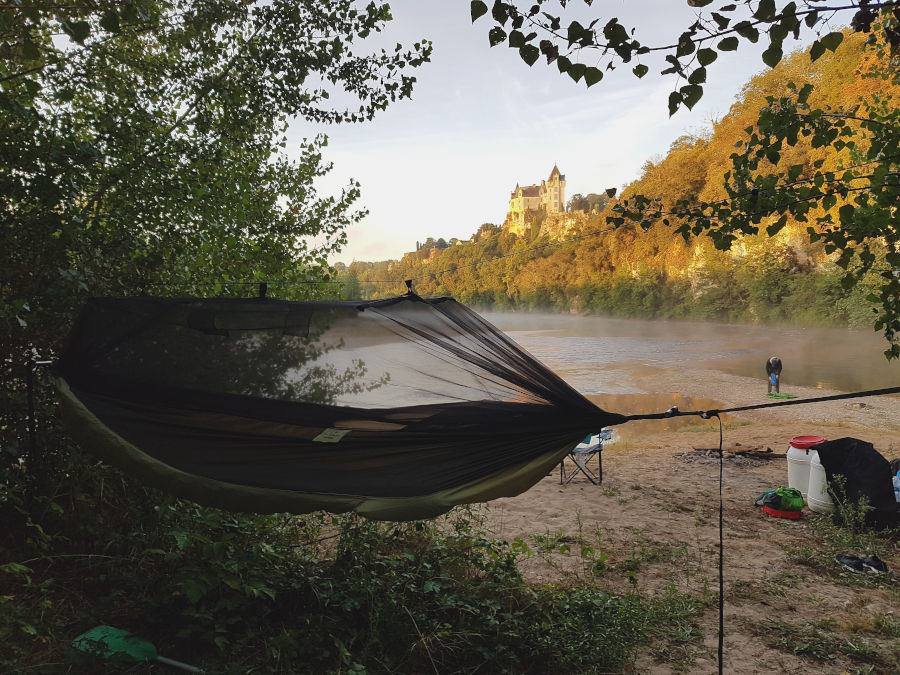
The night in the hammock was already quite fresh as the temperature dropped below 50°F. Without a good sleeping bag and a hammock in which you can insert a sleeping pad, this would probably not have been possible. Despite the cold we feel like in a paradise. The veil of mist that lies over the river, the sun that slowly rises and the castle on the rock that is touched by the first warm sunrays create a very special atmosphere. We got up early for our last paddling day, because we know that the last day of our tour will be waiting for us again with some highlights.
By passing Château de Montfort it is worthwhile to look back once again, as from the back, you can see some other parts of the castle and it looks much more imposing but also a little more built up and playful. Soon, we cross the bridge of Vitrac and from now on we notice that the real Dordogne-tourism begins. Big canoe rentals with their countless boats are waiting on the banks for the day tourists. We paddled the popular section between Vitrac and Beynac-et-Cazennac below weekdays in the low season and still there were a lot more people on the river than on the previous section. On summer weekends this section is without doubt very busy.
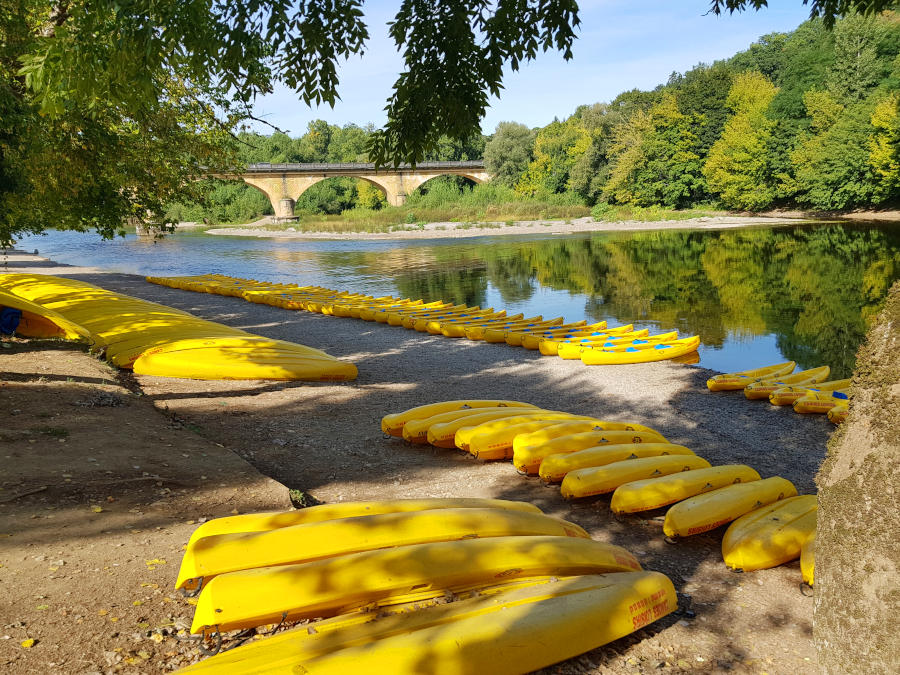
Not far from Vitrac, the village of Domme soon appears on the horizon on a rocky outcrop. A detour in this village is worthwhile in any case, because you find there many nice little shops, cafés and restaurants. We decide to have our lunch break in this village. As the village is located on a rocky outcrop, the view to the valley of the Dordogne is really impressive. But for this side trip you should already plan some hours, as from the shore, you have to walk up to the old town and this way is not really short.
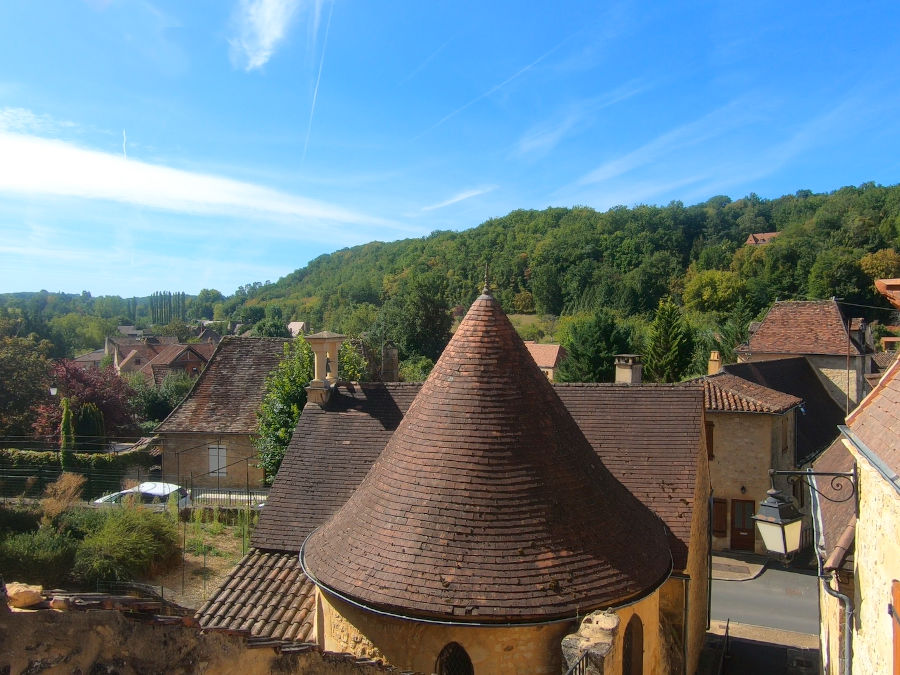
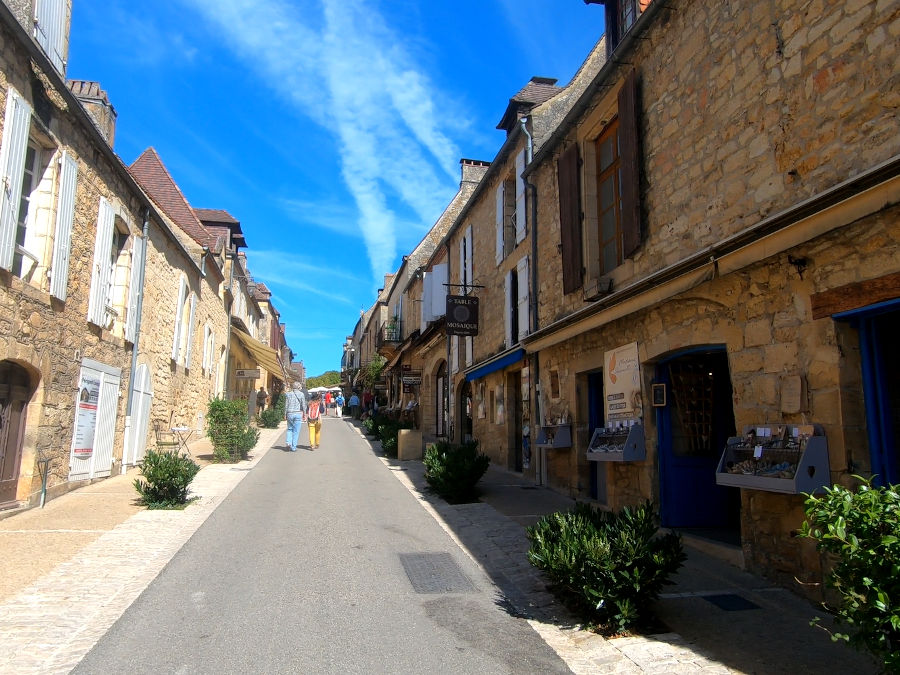

After the lunch break we continue in the direction of La Roque-Gageac. Also this village is really picturesque and those who did not make a side trip to Domme or wanted to spare themselves the hike up the mountain should stop at La Roque-Gageac. We land with our boat at the opposite side of the shore of the village and enjoy the view at the French village that appears to us as from a fairy-tale book. Between La Roque-Gageac and Château de Castelnaud there are excursion boats, but they are not very disturbing when canoeing, as the river is quite wide.
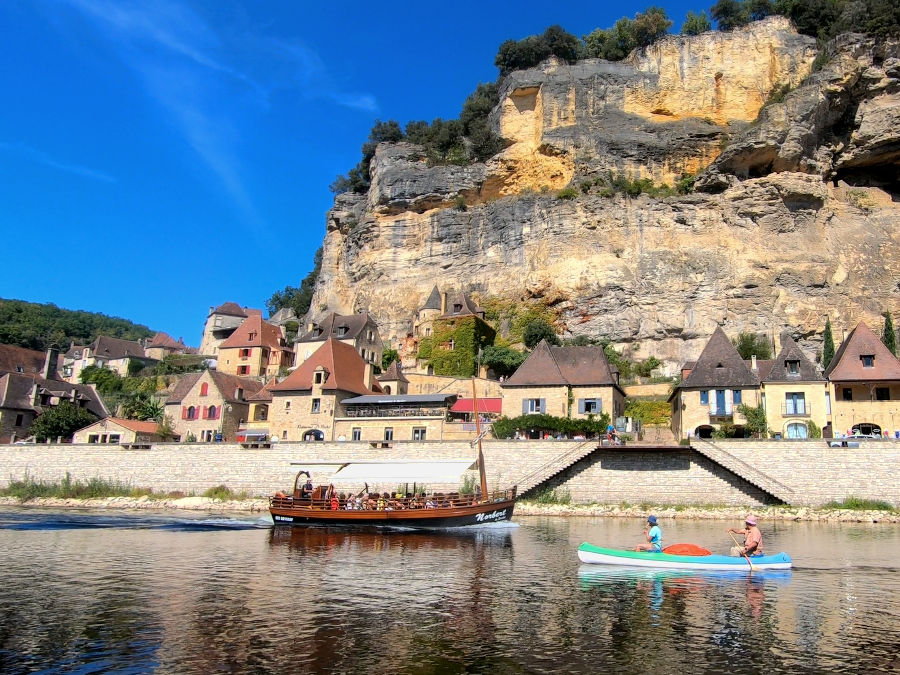
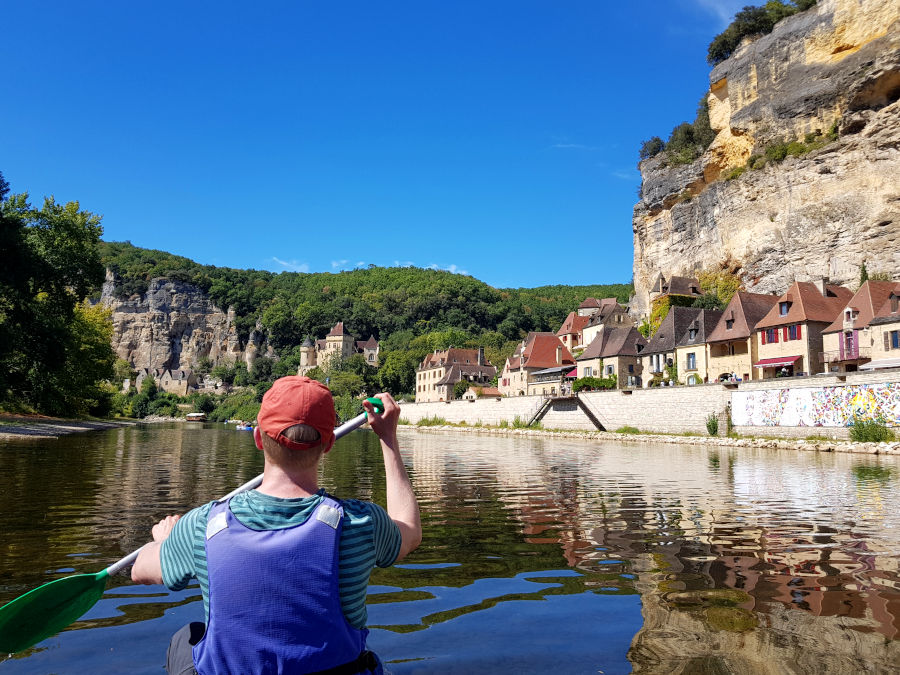
The Château de Castelnaut is a highlight of every Dordogne tour and is considered the most visited castle in the south of France. It not only has an interesting history to tell, but also houses a museum of medieval war machines. We visited it and were very fascinated by both the castle and the exhibition.
This castle was considered difficult to conquer due to its location and was looted and set on fire during the French Revolution. It was later used as a quarry to build bank fortifications on the Dordogne river. It was only in 1967 that it was elaborately rebuilt and since 2002 the castle has been shining in new splendour.
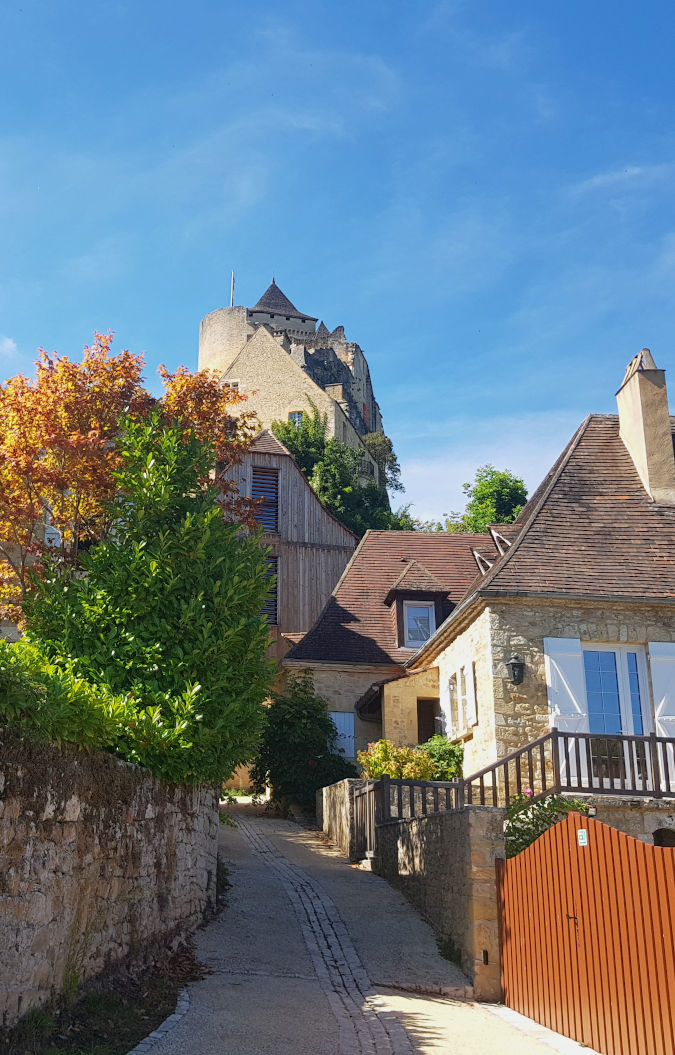
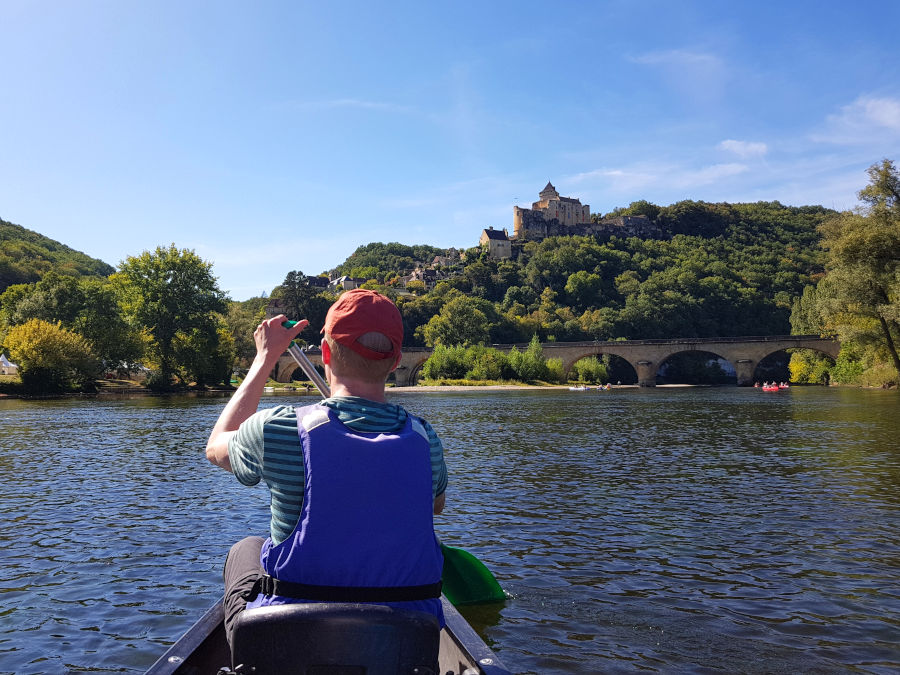
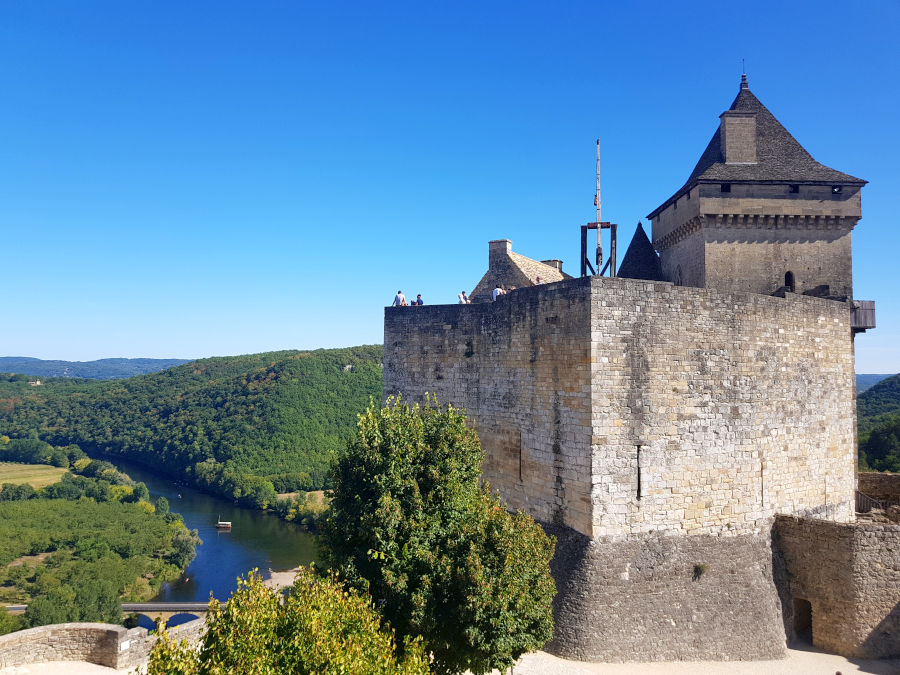
From the castle of Castelnaud it is really not far to Beynach-et-Cazenac. If you visit Castelnaud, you can already see the castle of Beynac from a distance. And not only this one, but also other castles that give this part of the Dordogne the nickname “castle section”.
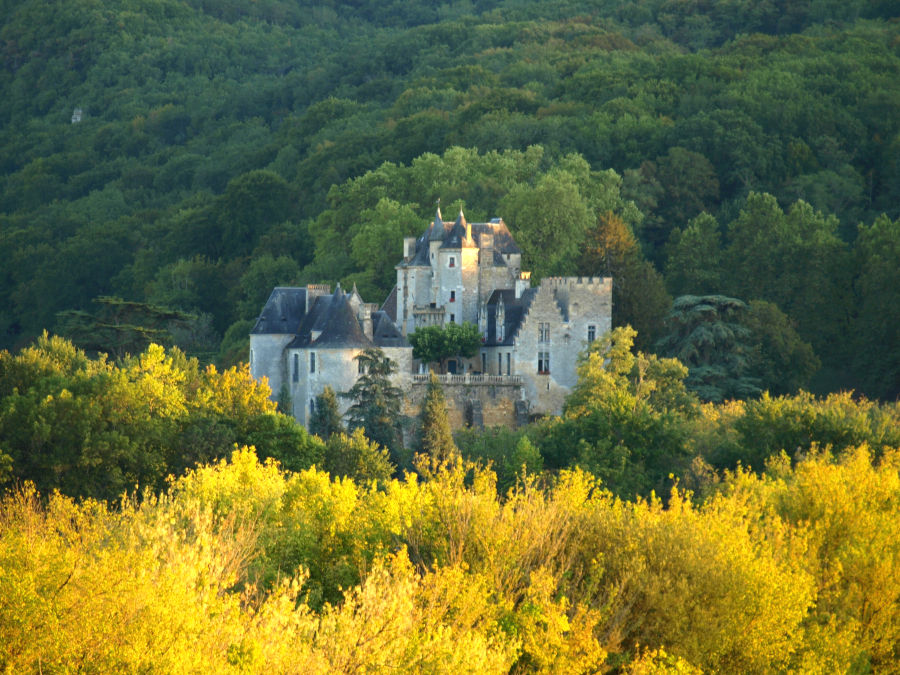
In Beynach-et-Cazenac our canoe tour finally ends after 6 days. On the last day we spend the night at the campsite “Camping le Capeyrou”. In summer it is said to be fully booked very quickly, but before and after the holiday season you can easily get a place spontaneously on the same evening. Unfortunately there is no direct access to the river from the campsite and so we have to leave our boat on the shore for the night.
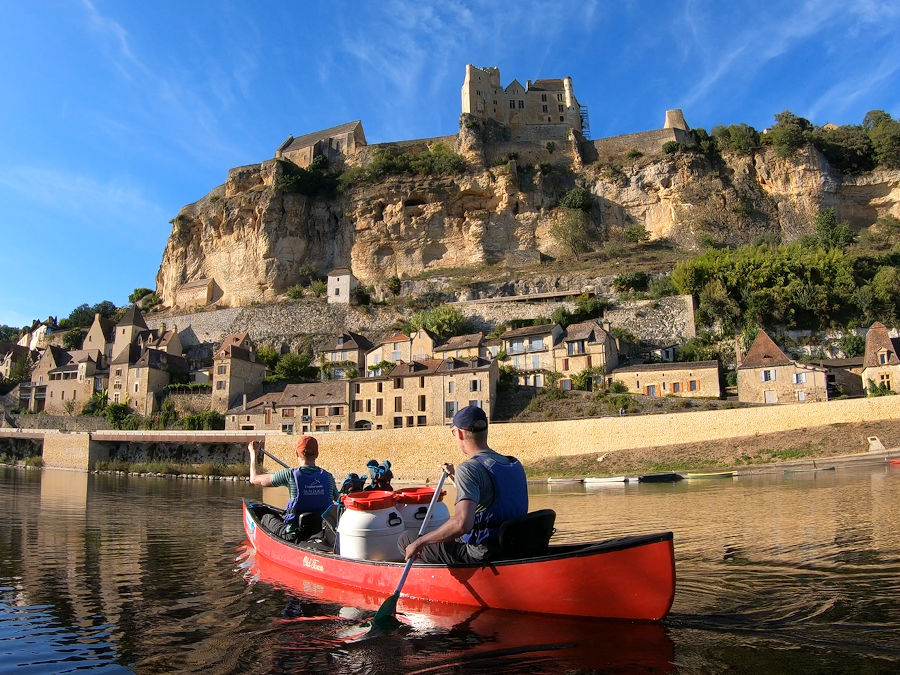
Since we arrived not too late and out tent is already pitched up, we take the opportunity to explore the village and walk up to the castle Beynac. For us the walk was a perfect end of the day. During the week in the low season there are very few people in the village in the evening and you can enjoy the medieval village as well as the beautiful views. But of course, during this time many restaurants are already closed. But we still find some places to stop at the river bank in order to finish the tour with a great dinner.
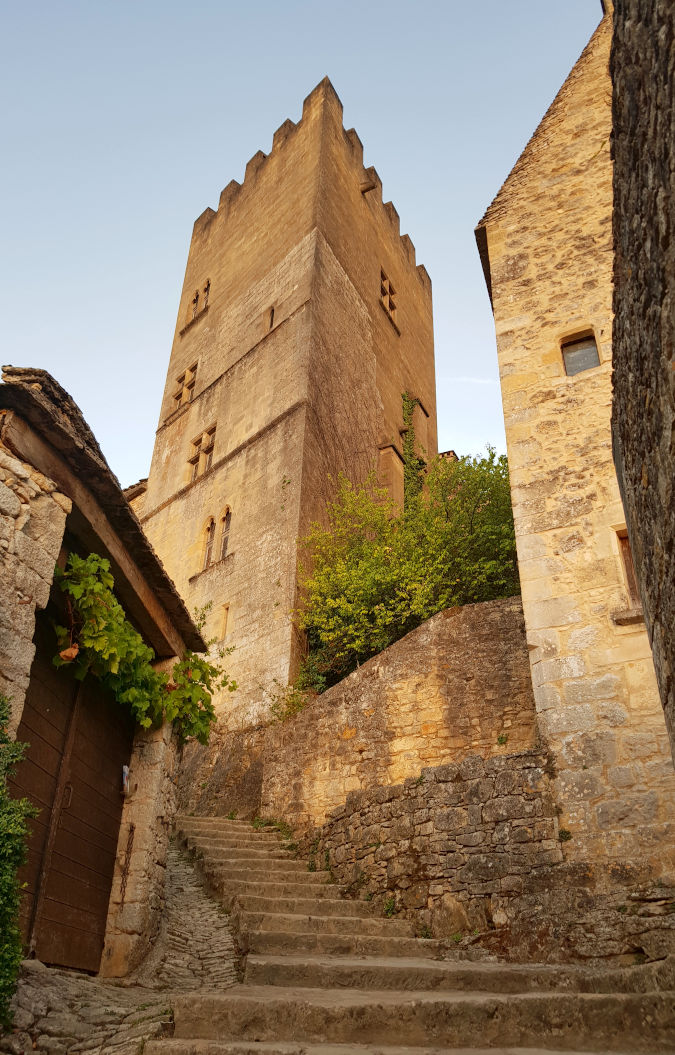
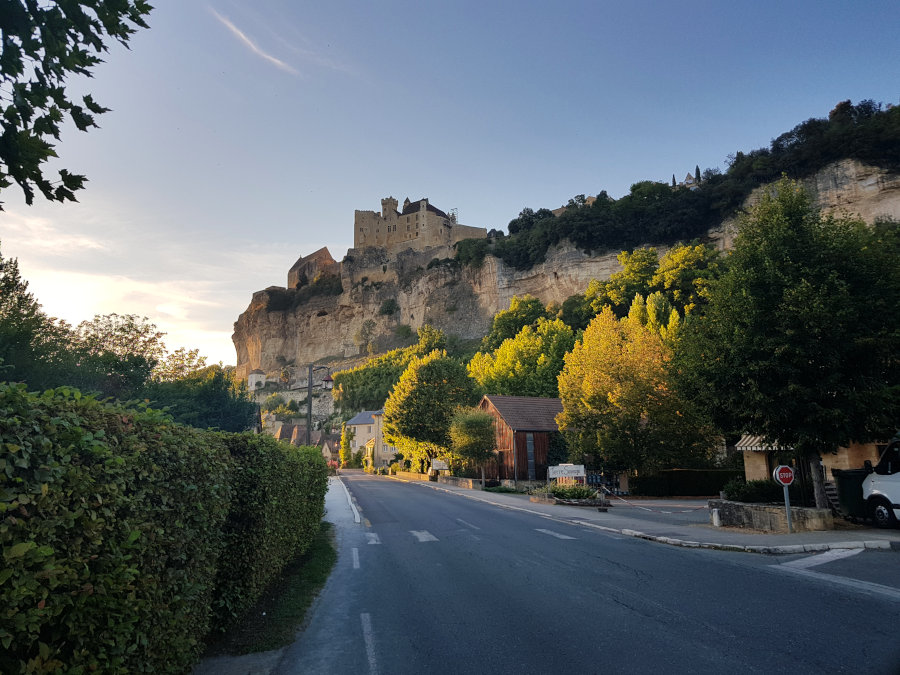
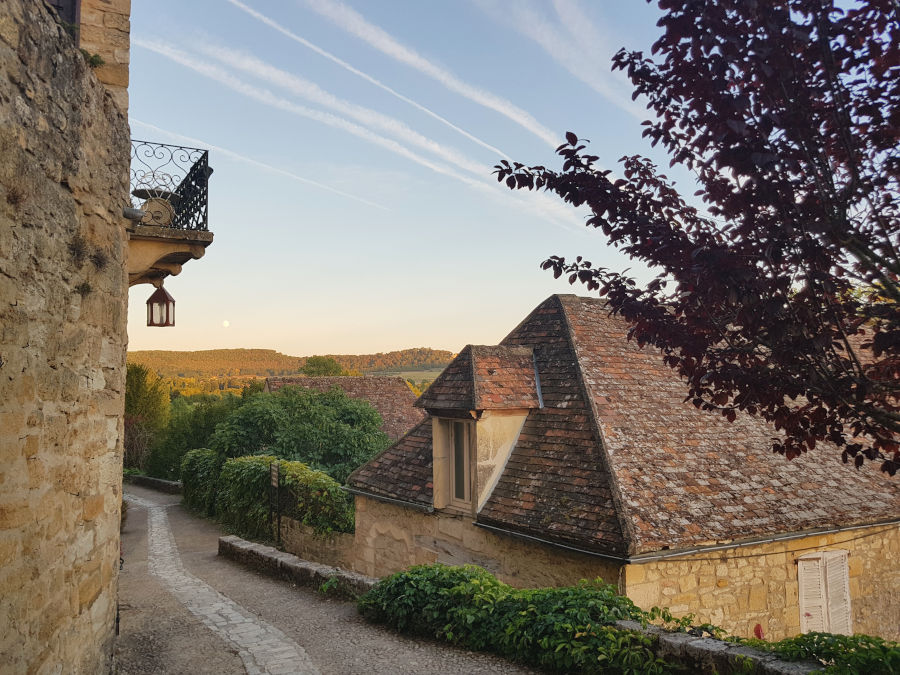
For the next morning we arranged our pick up with the canoe rental Explorando to get back to Groléjac where we had parked the rental car. Thus ends our Dordogne tour and we look back on eventful and relaxing days in a beautiful region between picturesque castles and villages and lots of nature.
These canoe tours in France might interest you too!
Did that report make you want to go on a canoe trip? Then inspire yourself by other tour reports from France. By the way, in our tours section you will find all the tour reports published so far as well as researched articles on selected paddling regions.
Kayaking in the Calanques National Park
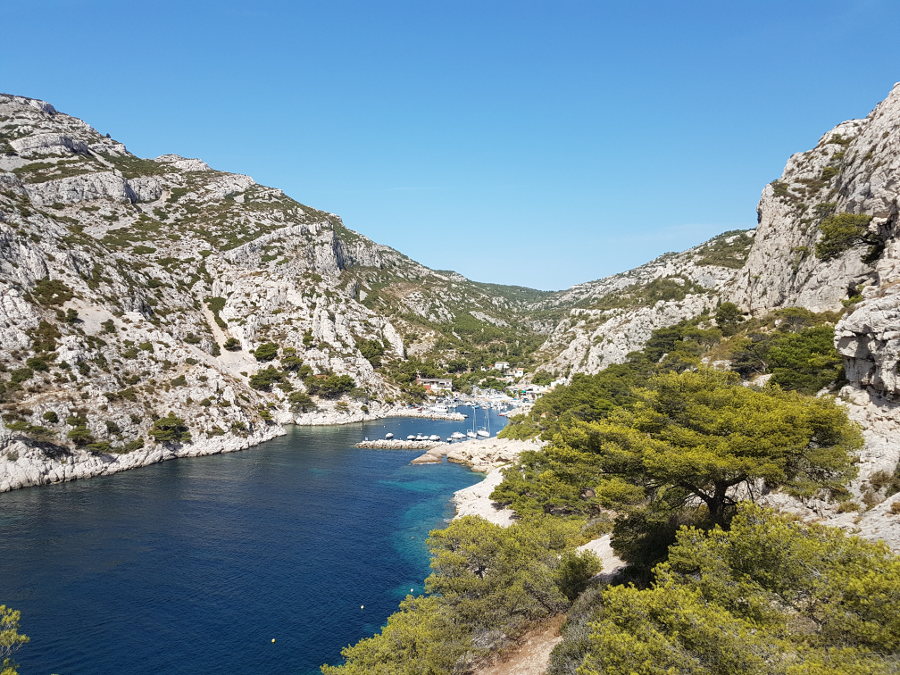
The French national park Les Calanques is considered a hiker’s paradise in France, combining mountains and dream beaches. For paddle fans this national park is a spectacular place for sea kayaking.
Tour report of the kayak tour in the Calanques
Kayaking to the Pont du Gard
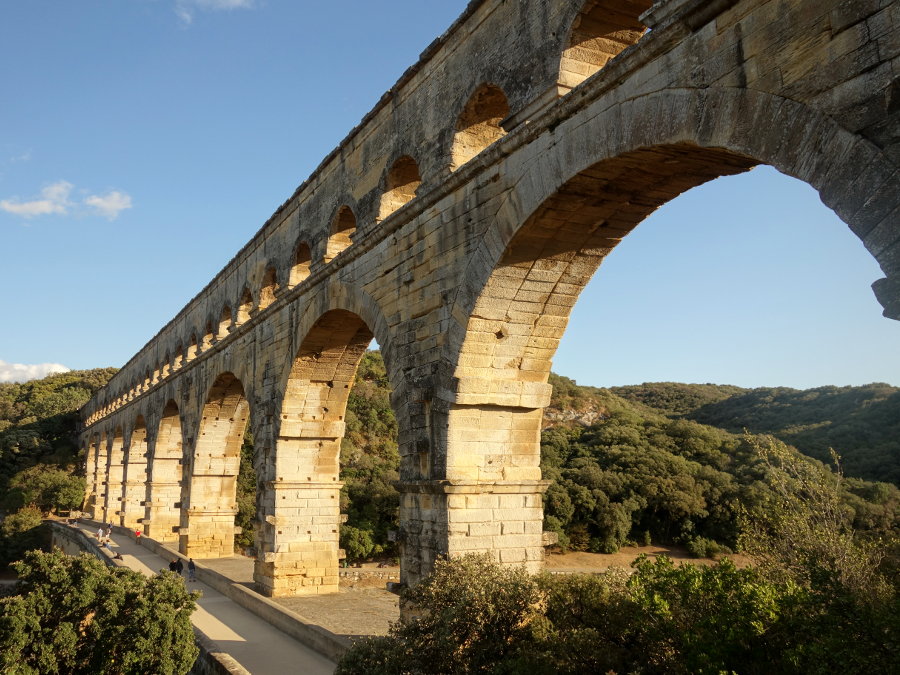
The Pont du Gard is a Roman aqueduct in the south of France and one of the most important sights in this region. A canoe trip to this historical monument is a very special experience.
Tour report of the canoe tour to the Pont du Gard